Special Report
The Drunkest (and Driest) Cities in America

Published:
Last Updated:

The subject of two constitutional amendments and the pillar of a major U.S. industry, alcohol is inextricably tied to America’s political and commercial history.
On an individual level, alcohol is a social lubricant known for its euphoric effects. But when it is misused, it can take an enormous toll. According to the Centers for Disease Control and Prevention, excessive alcohol use cost the U.S. economy $249 billion in 2015 alone, primarily in lost workplace productivity and health care costs.
[in-text-ad]
Excessive alcohol consumption patterns are not uniform across the nation, however, and residents of certain cities are much more likely to abuse alcohol than residents of others. 24/7 Wall St. reviewed excessive drinking rates in 381 metro areas to identify the drunkest and driest cities in the United States. Heavy drinking cities tend to have better educated, higher earning, and — counterintuitively — healthier populations than cities with the lowest excessive drinking rates.
Click here to see the drunkest cities in America.
Click here to see the driest cities in America.
Click here to see our detailed findings.
Click here to read our methodology.
The Drunkest Cities in America:
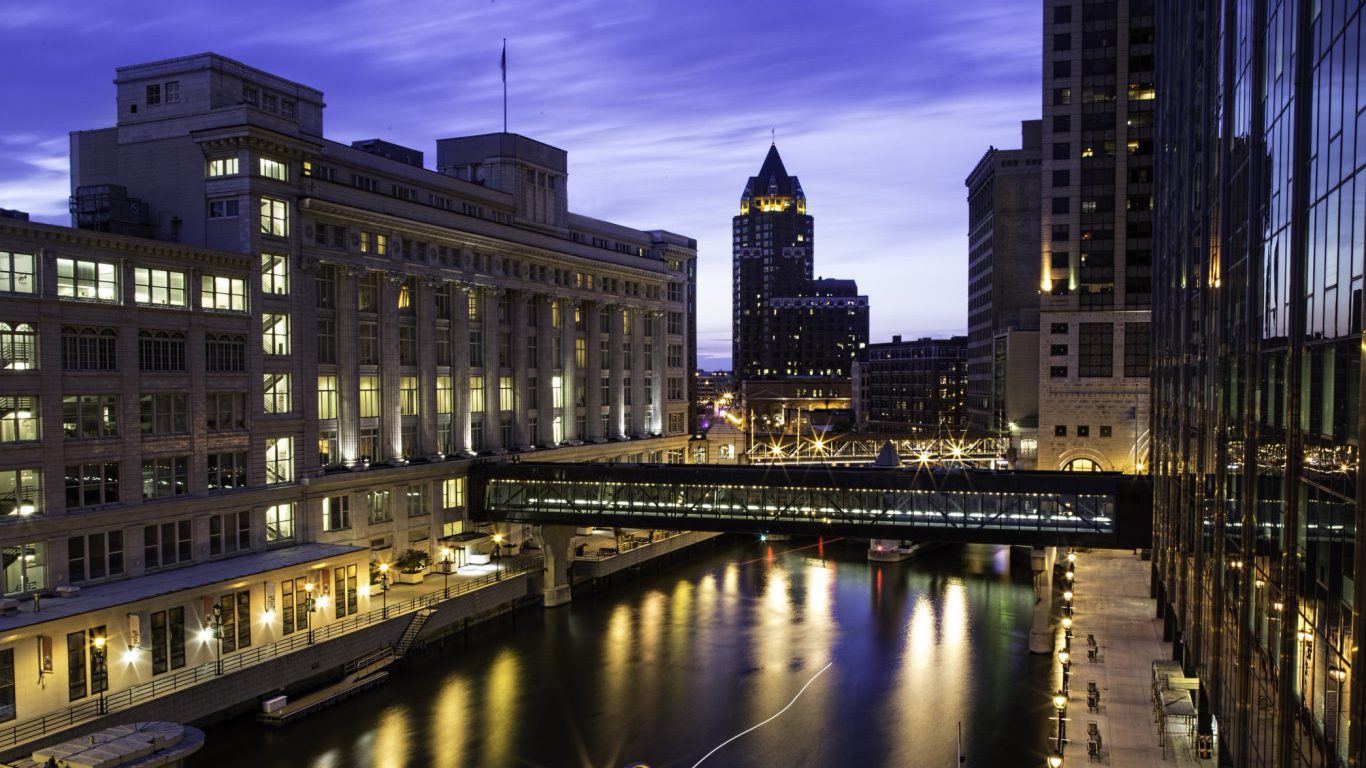
20. Milwaukee-Waukesha-West Allis, WI
> Pct. adults drinking to excess: 22.5%
> Pct. driving deaths involving alcohol: 36.4%
> Est. number of bars: 494
> Median household income: $56,247
Of the 20 cities with the largest share of heavily drinking adults, nine are in Wisconsin. Milwaukee, a city famous for its historic breweries, is one of them. There are 3.1 bars in the Milwaukee metro area for every 10,000 residents, well more than double the nationwide concentration of 1.3 bars per 10,000 people.
More venues to consume alcohol can lead to more widespread consumption. Some 22.5% of metro area adults drink excessively, well above the 18.0% share of American adults.
[in-text-ad]

19. Ames, IA
> Pct. adults drinking to excess: 22.7%
> Pct. driving deaths involving alcohol: 15.0%
> Est. number of bars: 20
> Median household income: $50,811
Some 22.7% of adults in the Ames metro area drink excessively, one of the highest such shares nationwide and the third highest share in Iowa. While excessive drinking is never healthy, adults in Ames are more likely to be in good health than most. Only 11.8% of adults in the metro area report being in fair or poor health, well below the 15.0% share of American adults.
The share of driving deaths involving alcohol tends to be higher in areas with higher excessive drinking rates. Ames, however, is an exception. Despite having one of the highest excessive drinking rates in the country, only 15% of driving deaths involve alcohol, half the 30% share nationwide.
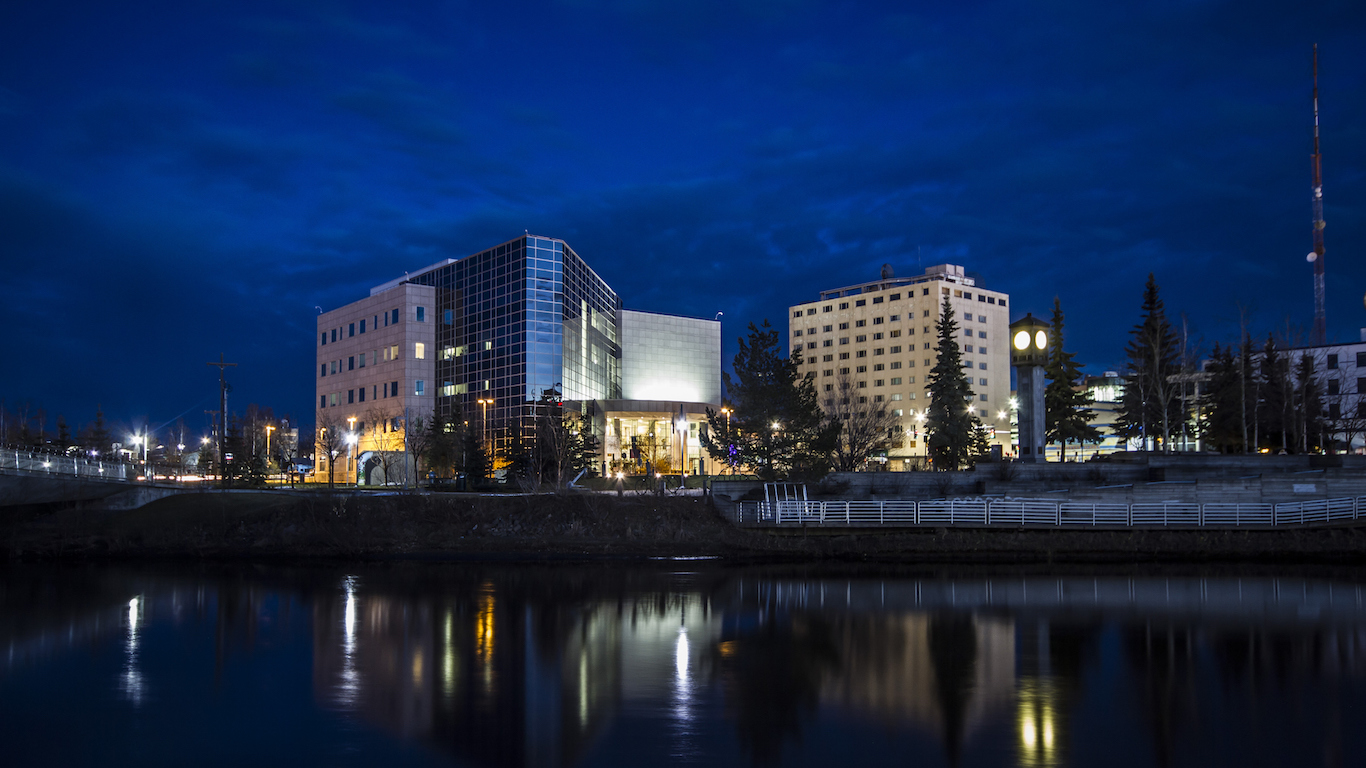
18. Fairbanks, AK
> Pct. adults drinking to excess: 22.7%
> Pct. driving deaths involving alcohol: 37.8%
> Est. number of bars: 20
> Median household income: $72,975
Fairbanks is the heaviest drinking metro area in one of the heaviest drinking states. An estimated 22.7% of adults in the Fairbanks metro area drink excessively, a slightly higher share than the 22.1% statewide excessive drinking rate. Fairbanks has one of the highest median household incomes in the country.
As is the case in many cities on this list, the higher excessive drinking rate in Fairbanks likely contributes to a greater share of fatal accidents involving alcohol. Some 37.8% of roadway fatalities in the metro area involve alcohol, above both the 33.8% statewide rate and the 30.0% national rate.
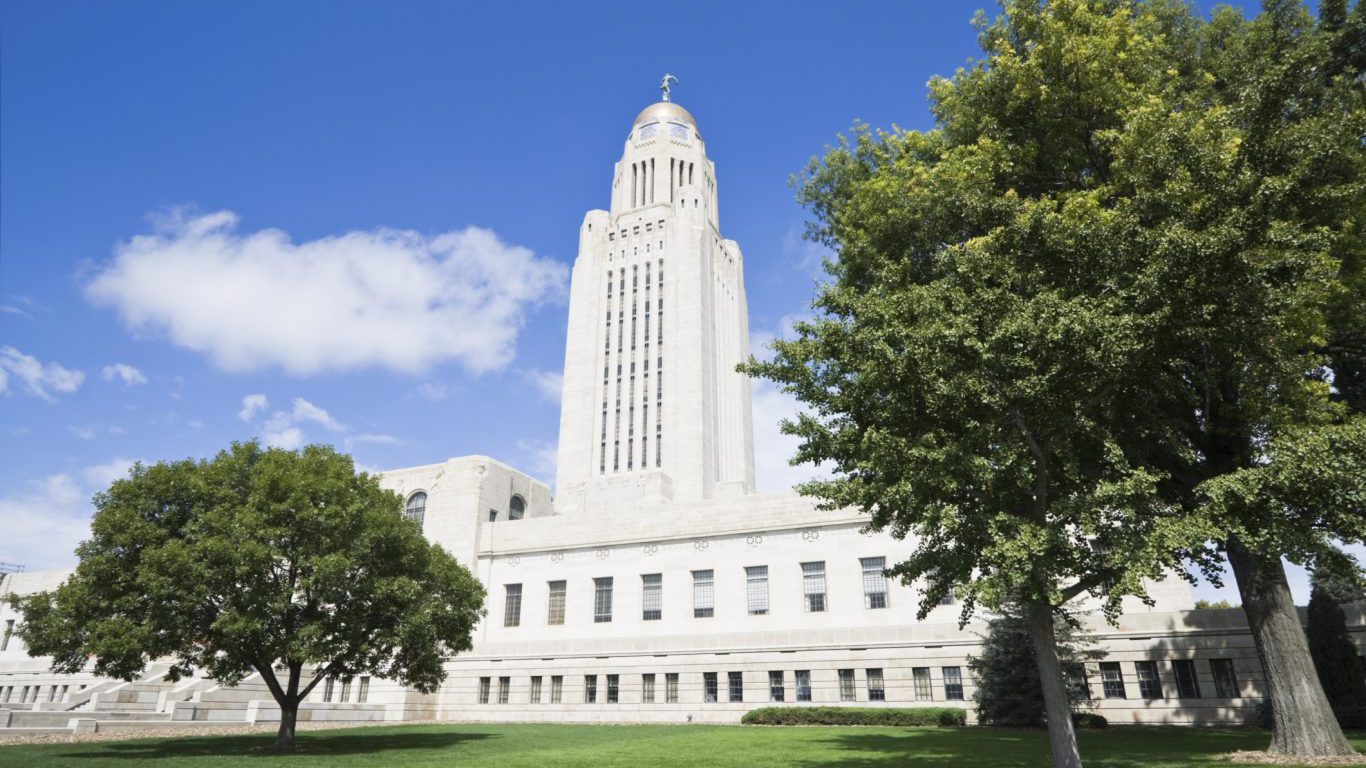
17. Lincoln, NE
> Pct. adults drinking to excess: 22.7%
> Pct. driving deaths involving alcohol: 25.5%
> Est. number of bars: 72
> Median household income: $54,002
Nearly 23% of adults in Lincoln drink excessively, the highest share in Nebraska and one of the highest shares of U.S. cities. While excessive drinking is unhealthy behavior by definition, negative consequences associated with binge and heavy drinking are often not apparent when reviewing health outcomes across a population. For example, Lincoln is one of only two U.S. metro areas where fewer than 10% of adults report being in fair or poor health.
Americans with greater financial means are more likely to be able to drink to excess. With higher incomes come other positive health outcomes that can offset the negative health effects of excessive alcohol consumption. Lincoln’s median household income is roughly in line with the state.
[in-text-ad-2]

16. Watertown-Fort Drum, NY
> Pct. adults drinking to excess: 22.9%
> Pct. driving deaths involving alcohol: 32.8%
> Est. number of bars: 22
> Median household income: $51,107
The 22.9% excessive drinking rate in Watertown is the highest of any New York state metro area and well above the 18.0% national rate. Perhaps as a result of this relatively widespread abuse, alcohol is a greater factor in driving deaths. Nearly a third of all fatal traffic accidents in Watertown involve alcohol, the second highest share of the 11 metro areas across the state.
Alcohol consumption is not the only unhealthy behavior area residents engage in. The 18.7% smoking rate in Watertown is well above the 15.2% statewide smoking rate.
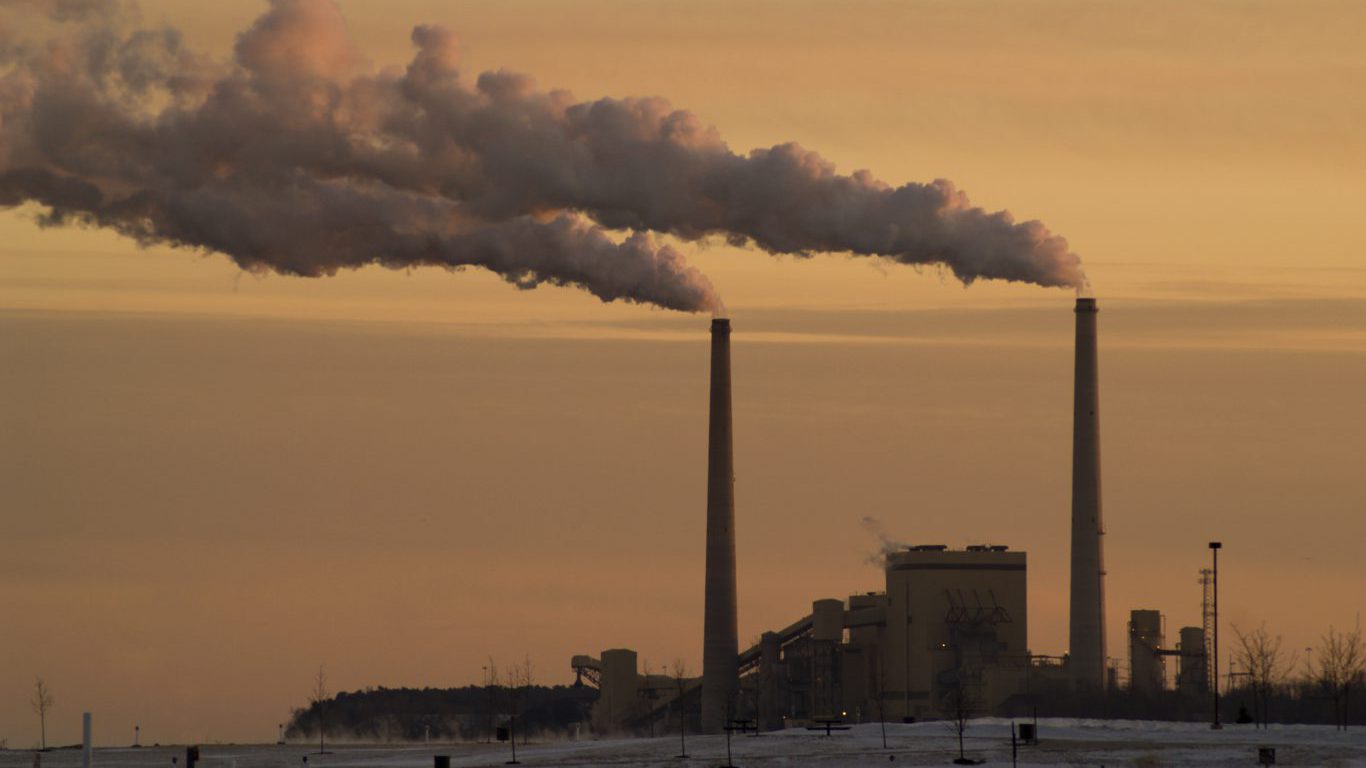
15. Sheboygan, WI
> Pct. adults drinking to excess: 23.0%
> Pct. driving deaths involving alcohol: 27.1%
> Est. number of bars: 54
> Median household income: $57,047
Excessive drinking is more common in Sheboygan, Wisconsin than in all but 14 other U.S. metro areas. This high excessive drinking rate may be fueled in part by area residents’ widespread access to drinking establishments. There are about 4.7 bars in the metro area for every 10,000 residents, more than in all but half a dozen U.S. metros and well more than triple the national concentration of 1.3 bars per 10,000 Americans.
The typical household in Sheboygan has an income of $57,047, slightly higher than both the national and state median household income. With higher incomes come other positive health outcomes that can offset the negative health effects of excessive alcohol consumption. Lincoln’s median household income is roughly in line with the state. Just 12.7% of adults in the metro area report fair or poor health, a lower share than in all but a few metro areas.
[in-text-ad]

14. Dubuque, IA
> Pct. adults drinking to excess: 23.0%
> Pct. driving deaths involving alcohol: 40.0%
> Est. number of bars: 33
> Median household income: $58,487
Across the Dubuque metro area, 23% of adults drink excessively, the second highest share of any Iowa metro area and well above the 18.0% national share. As is the case in many cities with high excessive drinking rates, deadly car accidents in Dubuque have a greater chance of being related to alcohol. Of all deadly accidents in the metro area, 40% involve alcohol, one of the largest such shares in the country and well above the comparable 25.4% share of deadly accidents statewide.
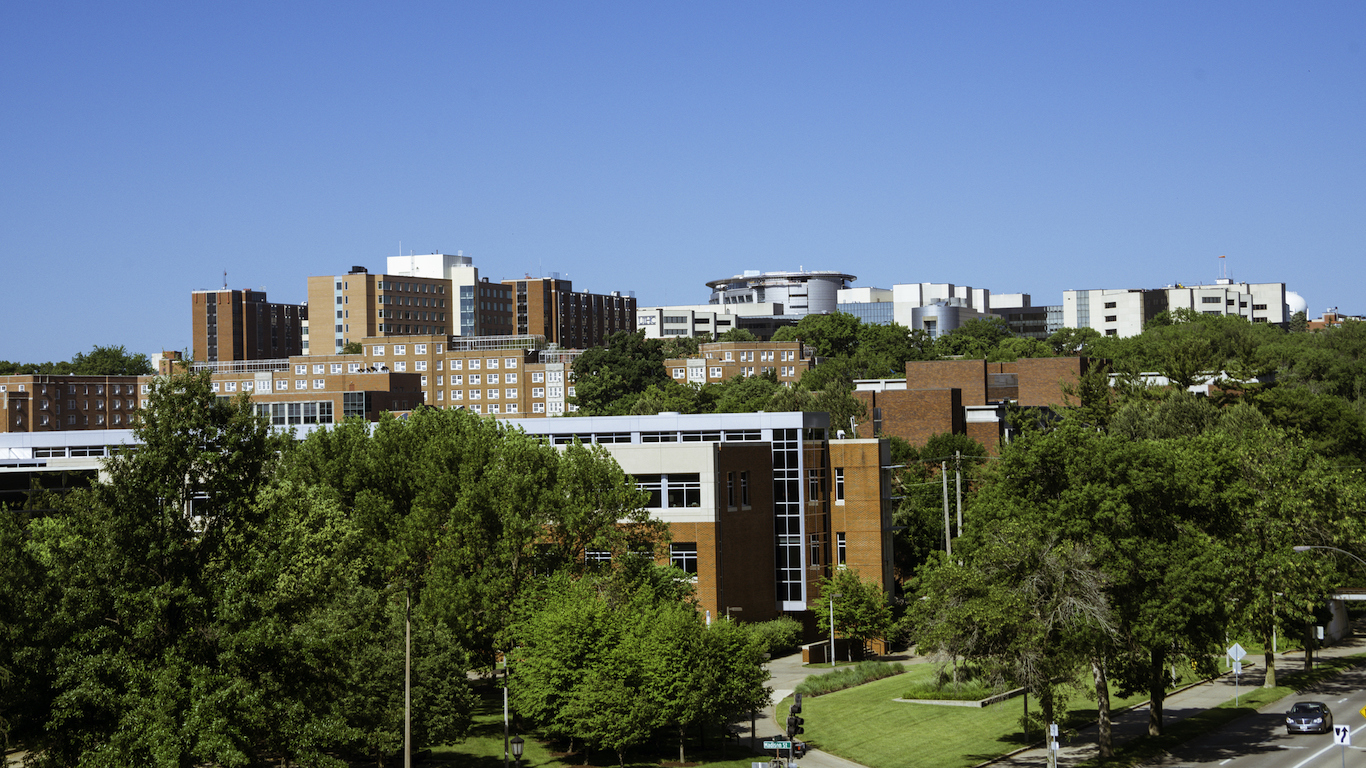
13. Iowa City, IA
> Pct. adults drinking to excess: 23.1%
> Pct. driving deaths involving alcohol: 17.7%
> Est. number of bars: 45
> Median household income: $55,332
The excessive drinking rate in Iowa City exceeds the excessive drinking rate in all but a dozen other U.S. cities. Excessive drinking is unhealthy and can impair judgement, leading to higher rates of certain risky behaviors.
However, across the metro area’s population, excessive drinking does not appear to be taking a significant toll. For example, only 17.7% of deadly car accidents in Iowa City involve alcohol, and only 11.1% of metro area adults report being in fair or poor health, each among the smallest such shares in the country.

12. Fond du Lac, WI
> Pct. adults drinking to excess: 23.5%
> Pct. driving deaths involving alcohol: 27.0%
> Est. number of bars: 40
> Median household income: $57,620
Fond du Lac is one of the heaviest drinking metro areas in the second heaviest drinking state. Some 23.5% of metro area adults drink excessively, well above the national excessive drinking rate of 18.0%. Excessive drinking is even more common across Wisconsin as a whole, with 24.5% of adults in the state either binge or heavily drink.
As is the case in most cities on this list, Fond du Lac has a high concentration of bars. Across the metro area, there are 3.9 bars for every 10,000 people, triple the national concentration of 1.3 bars per 10,000 people.
[in-text-ad-2]
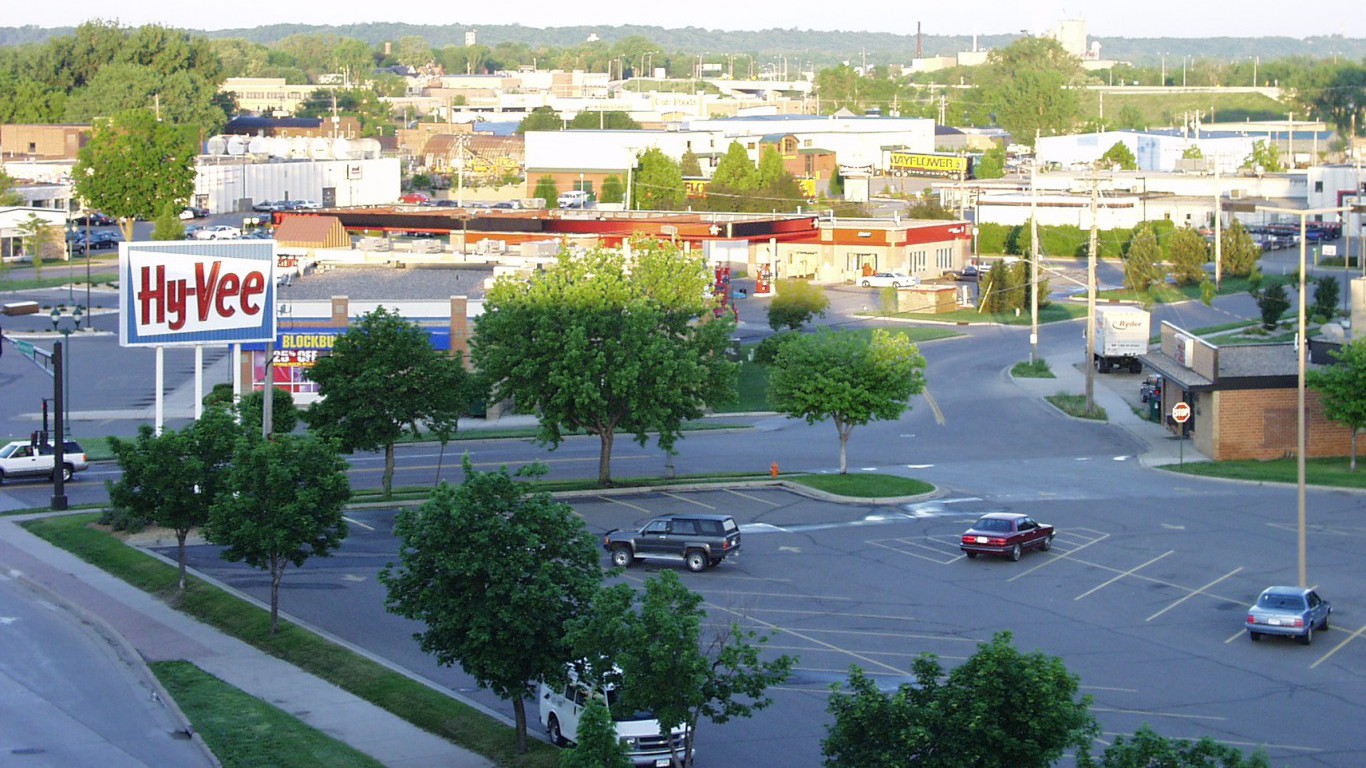
11. Mankato-North Mankato, MN
> Pct. adults drinking to excess: 23.6%
> Pct. driving deaths involving alcohol: 18.0%
> Est. number of bars: 21
> Median household income: $52,497
Mankato-North Mankato is one of five metro areas in Minnesota to rank among the heaviest drinking in the United States. Binge and heavy drinking is relatively common on college campuses, and home to Minnesota State, the Mankato metro area has a disproportionately large share of students. Some 17.4% of metro area adults are enrolled in college or graduate school, a far higher share than the 7.0% of Americans.
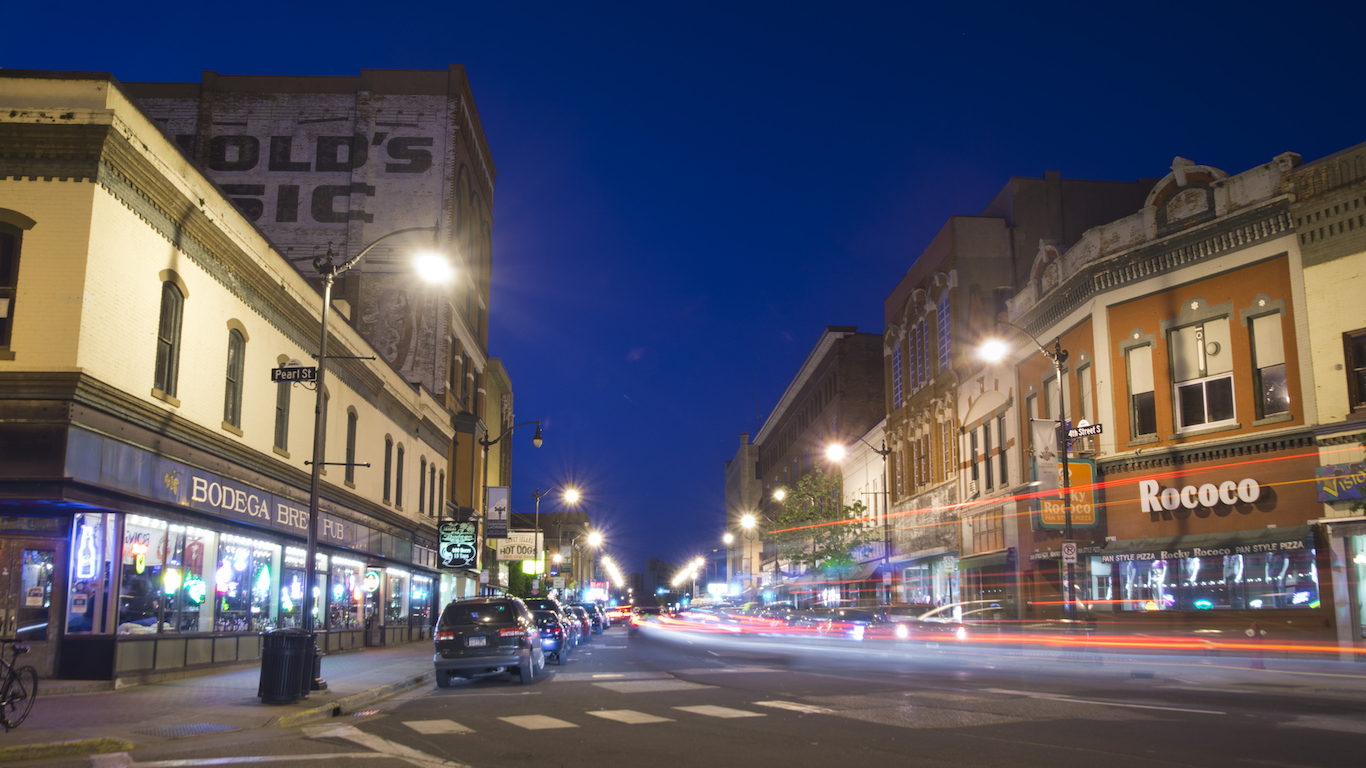
10. La Crosse-Onalaska, WI-MN
> Pct. adults drinking to excess: 23.8%
> Pct. driving deaths involving alcohol: 26.4%
> Est. number of bars: 88
> Median household income: $50,705
The 23.8% excessive drinking rate in the La Crosse, Minnesota metro area is higher than in the vast majority of U.S. metro areas and slightly higher than the 21.1% statewide excessive drinking rate.
Excessive drinking has considerable economic implications. According a study published in the American Journal of Preventative Medicine, excessive drinking costs the U.S. economy $249.0 billion 2015. Much of that cost was in the form of medical treatment and lost productivity. In La Crosse, however, drinking is big business. With 6.4 bars for every 10,000 residents, the metro area has the highest concentration of drinking establishments of any U.S. metro area.
[in-text-ad]
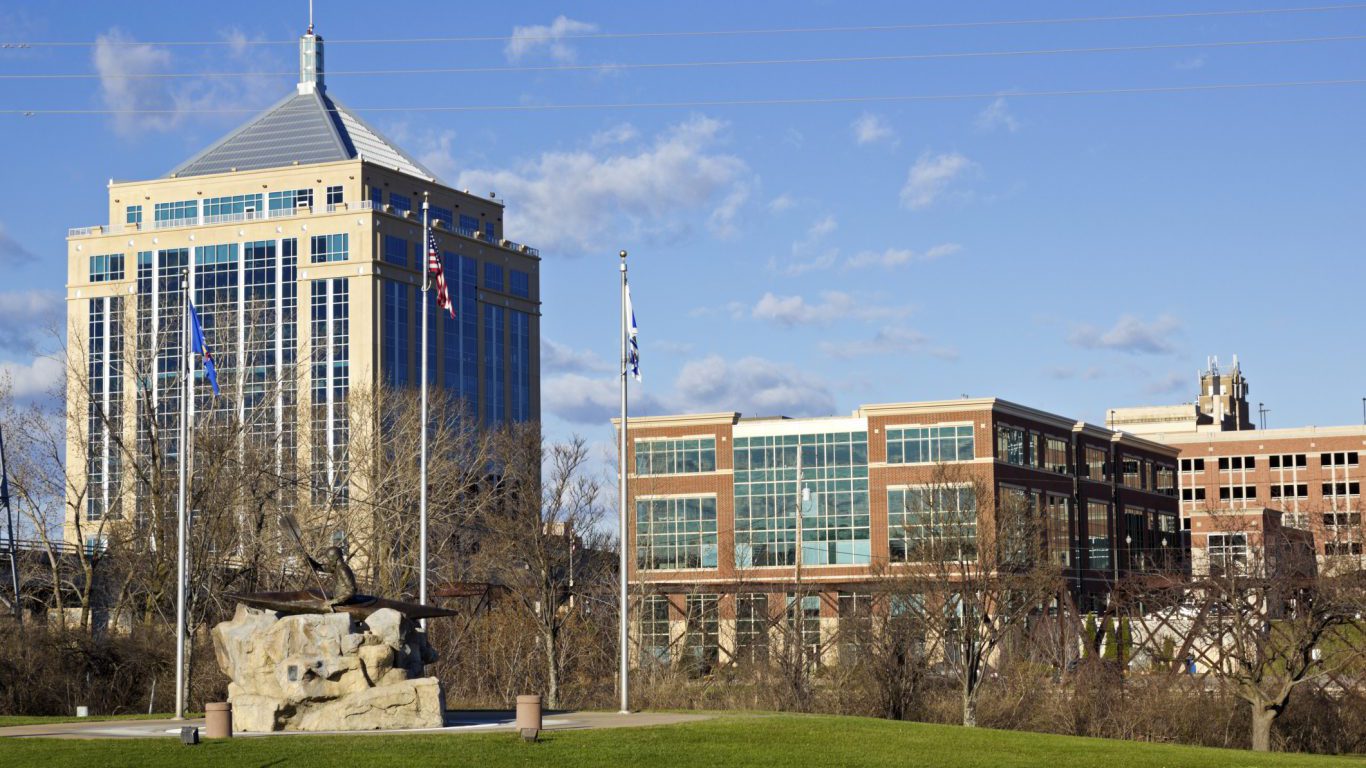
9. Wausau, WI
> Pct. adults drinking to excess: 24.2%
> Pct. driving deaths involving alcohol: 28.9%
> Est. number of bars: 57
> Median household income: $55,687
With 24.2% of adults reporting excessive drinking in the last 30 days, Wausau is one of 10 Wisconsin metro areas to rank among the heaviest drinking nationwide. Wisconsin’s excessive drinking rate of 24.5% is itself higher than in most of the state’s metro areas, including Wausau.
Binge drinking is less common among low income individuals, and very few Wausau metro area residents face serious financial hardship. The metro area’s poverty rate of 8.9% is one of the lowest of any U.S. metros and well below the 14.7% national poverty rate.
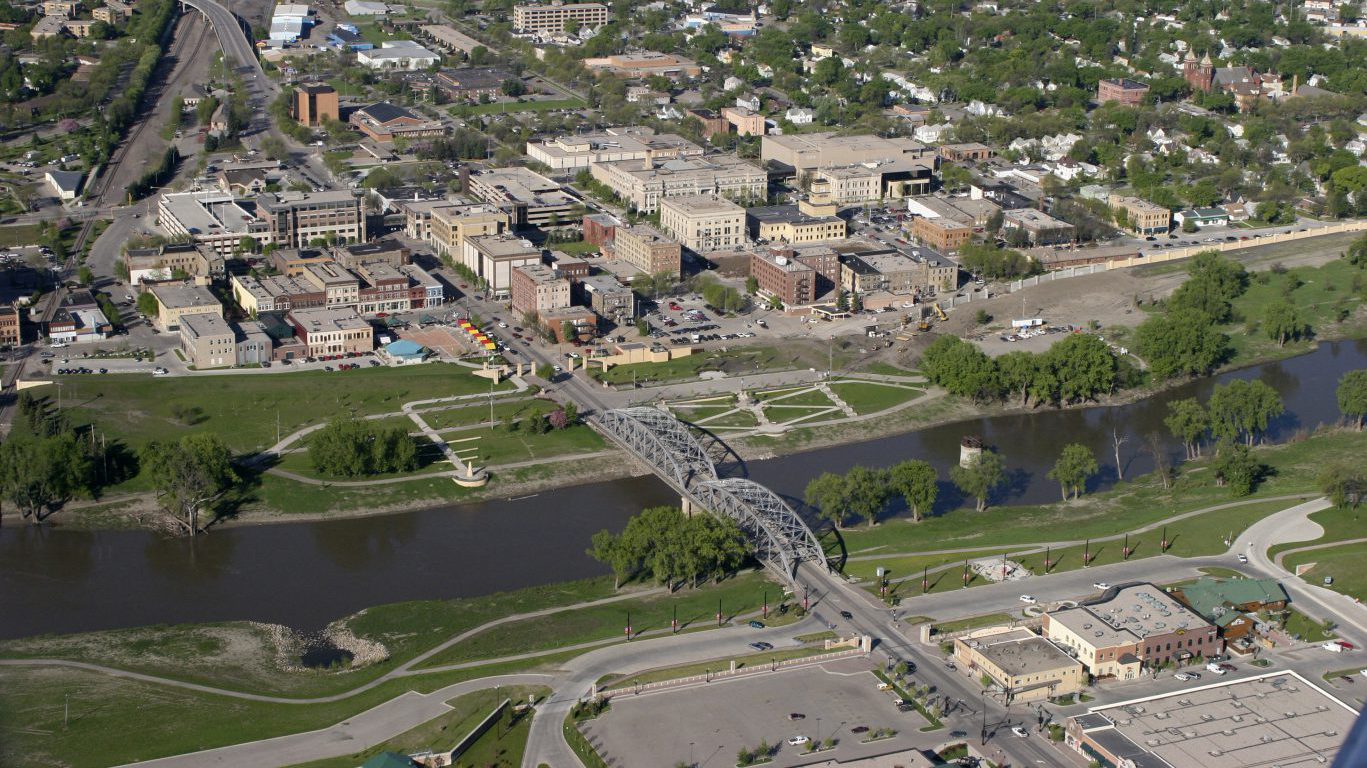
8. Grand Forks, ND-MN
> Pct. adults drinking to excess: 24.2%
> Pct. driving deaths involving alcohol: 34.0%
> Est. number of bars: 45
> Median household income: $53,443
Excessive drinking is more prevalent among college students than the population at large. In the Grand Forks metro area, home to the University of North Dakota, 13.0% of residents are either in college or graduate school, nearly double the comparable 7.0% share nationwide. A large college population may partially explain the metro area’s near nation-leading 24.2% excessive drinking rate.
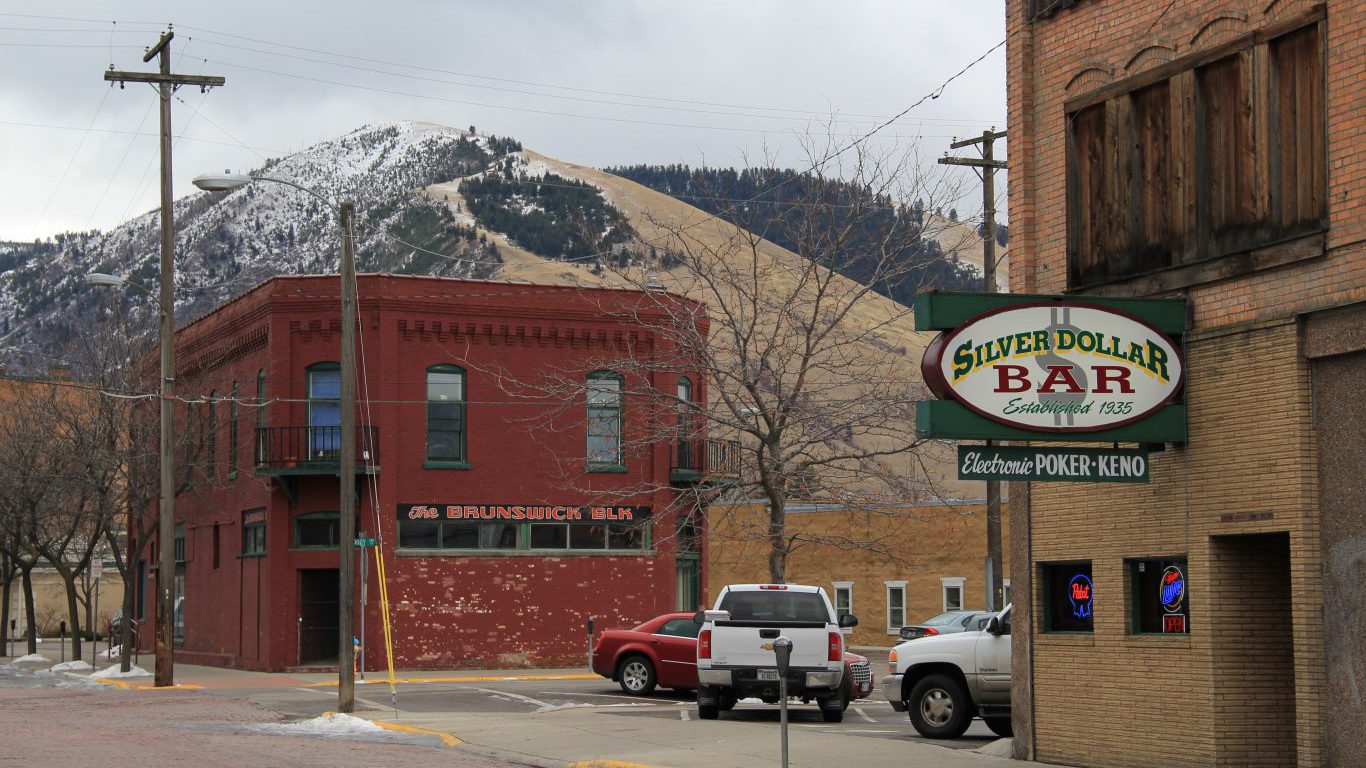
7. Missoula, MT
> Pct. adults drinking to excess: 24.3%
> Pct. driving deaths involving alcohol: 44.4%
> Est. number of bars: 41
> Median household income: $42,815
According to the CDC, binge drinkers are 14 times more likely to report impaired driving. In the Missoula metro area, where nearly one-in-four adults report drinking excessively in the last 30 days, 44.4% of all driving deaths involve alcohol, one of the highest such shares of any metro area and well above the comparable 30% national share.
Affluent individuals are more likely to have the means to drink to excess, but relative to the other metropolitan areas on this, Missoula is relatively low-income. The typical area household has an income of just $42,815. It is the only metro area on this list with a median household income below $50,000.
[in-text-ad-2]
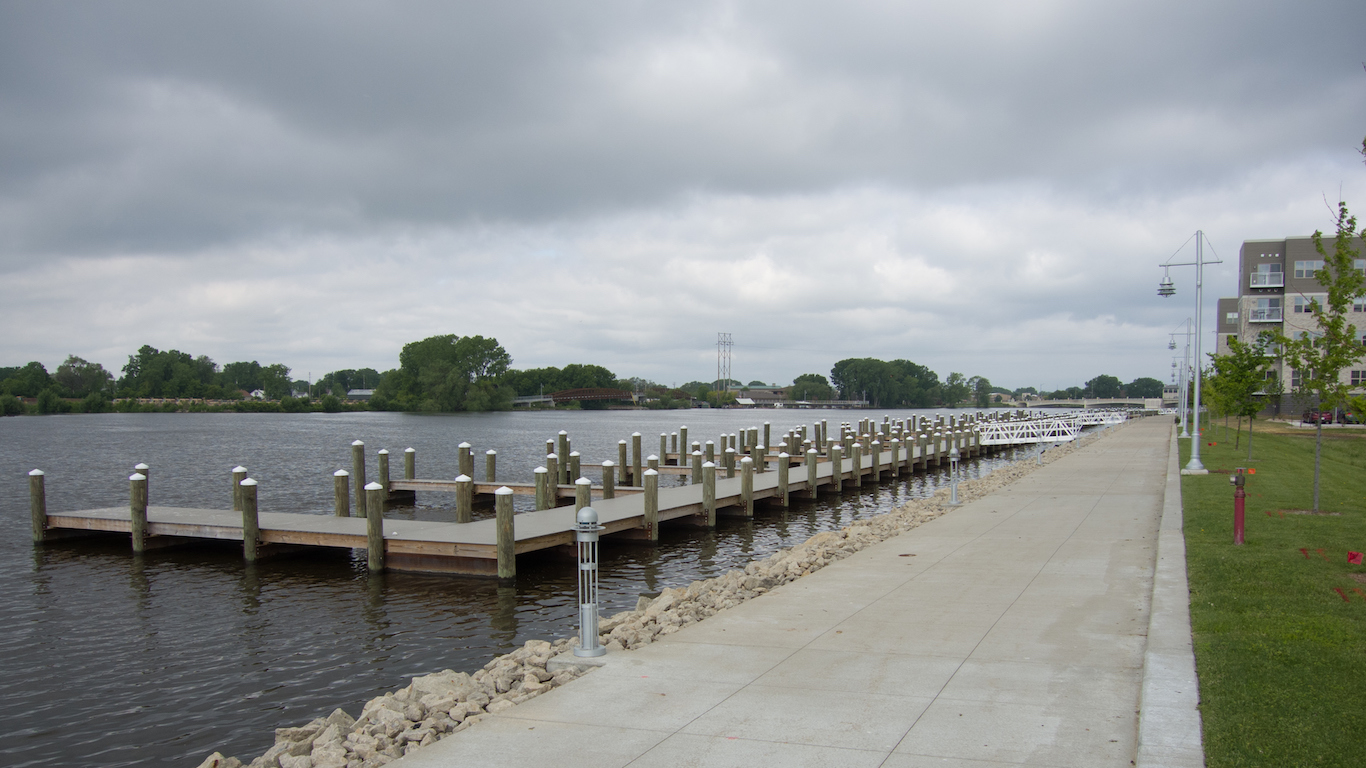
6. Oshkosh-Neenah, WI
> Pct. adults drinking to excess: 24.5%
> Pct. driving deaths involving alcohol: 47.9%
> Est. number of bars: 93
> Median household income: $52,136
In the Oshkosh-Neenah metro area, 24.5% of adults report drink excessively, exactly the same as the share of adults statewide reporting excessive drinking.
Driving many area residents to consume to excess may be the widespread availability of drinking establishments in the area. There are an estimated 93 bars in the Oshkosh-Neenah metro area, or about 5.5 for every 10,000 people, the third highest concentration among U.S. metro areas.

5. Fargo, ND-MN
> Pct. adults drinking to excess: 25.2%
> Pct. driving deaths involving alcohol: 38.0%
> Est. number of bars: 74
> Median household income: $56,051
Fargo has the fifth highest share of adults reporting excessive drinking among all U.S. metro areas. The metro also has the highest excessive drinking rate outside of metros in Wisconsin. Slightly more than one in four metro area adults report either drinking heavily or binge drinking in the last 30 days.
As is the case in many of the heaviest drinking cities, a disproportionate share of the Fargo population is enrolled in a higher education institution. Some 12.9% of the metro area’s 234,000 residents are either in college or graduate school, well above the 7.0% national share.
[in-text-ad]
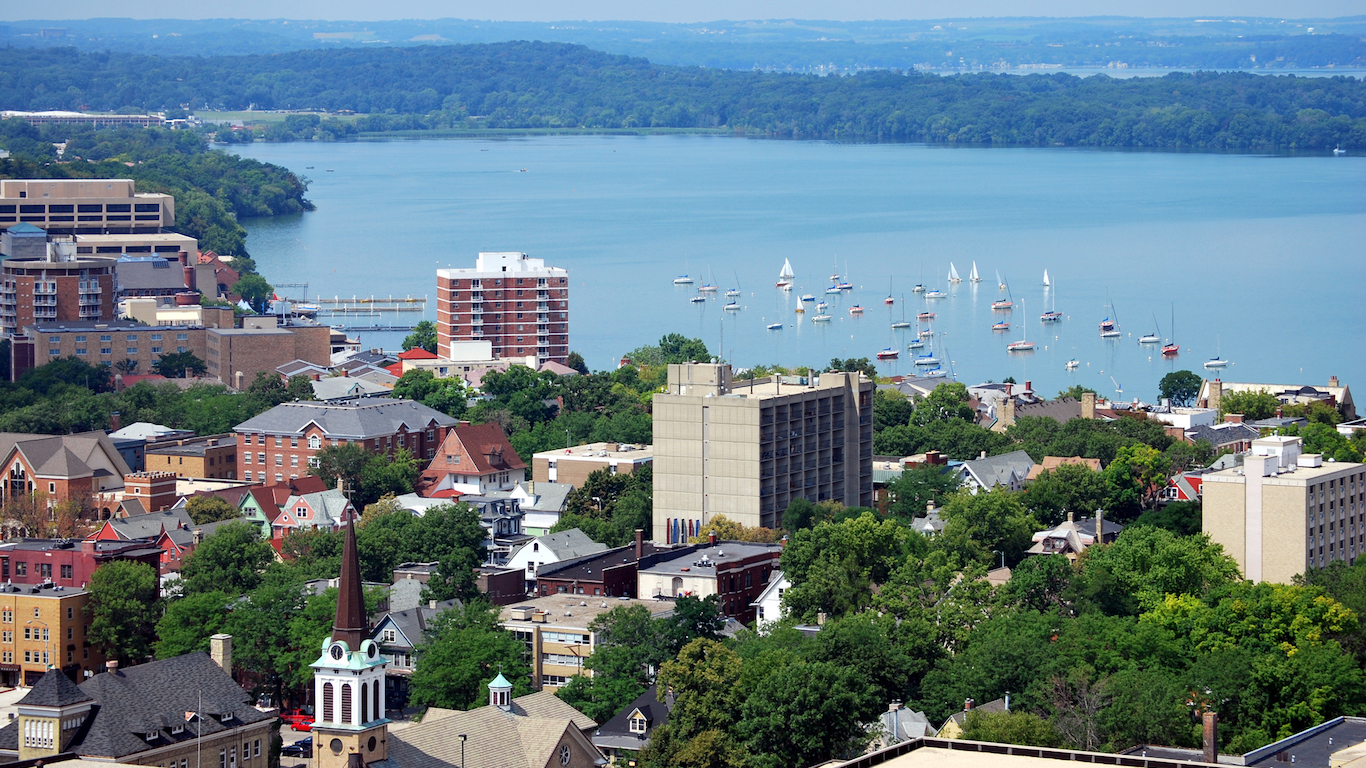
4. Madison, WI
> Pct. adults drinking to excess: 25.9%
> Pct. driving deaths involving alcohol: 38.0%
> Est. number of bars: 216
> Median household income: $64,174
While not the heaviest drinking metro area in Wisconsin, the state capital comes close. The Madison metro area is one of only five in the United States where more than one in every four adults drinks excessively.
Excessive drinking is never healthy, and despite any negative toll heavy drinking is taking on the Madison population, people in the city tend to be relatively healthy on the whole. Only 11.5% of metro area adults report being in fair or poor health, one of the smallest shares of any U.S. metro area and well below the 15.0% national share.
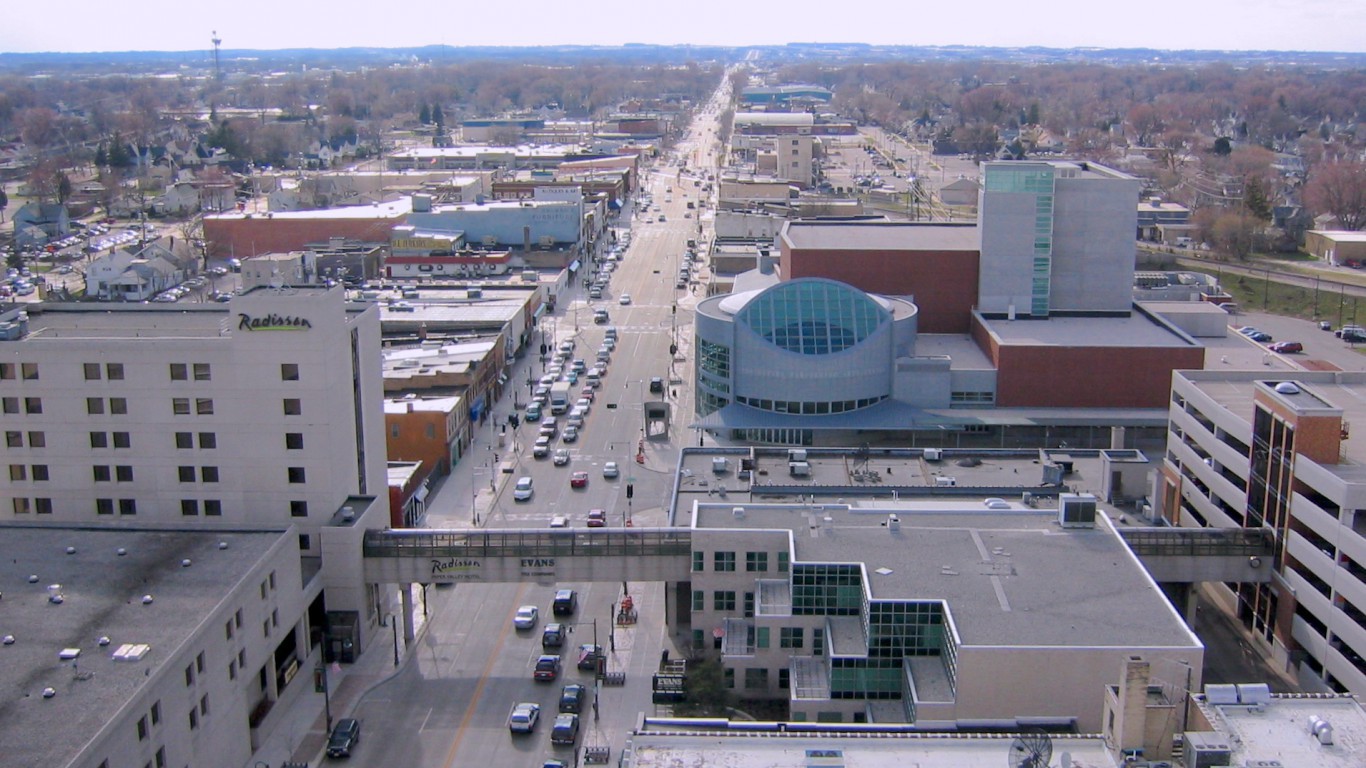
3. Appleton, WI
> Pct. adults drinking to excess: 26.2%
> Pct. driving deaths involving alcohol: 25.7%
> Est. number of bars: 108
> Median household income: $61,245
Some 26.2% of Appleton residents drink excessively, the third highest share of U.S. metro areas According to the CDC, binge drinking is more common in households earning $75,000 or more a year. A greater than typical share of Appleton residents are likely earning as much as the metro area’s median household income is $61,245 a year, well above the national median income of $55,775. Additionally, poorer individuals are less likely to drink excessively, and Appleton’s poverty rate of 9.4% is one of the smallest rates of any metro area and well below the 14.7% national poverty rate.
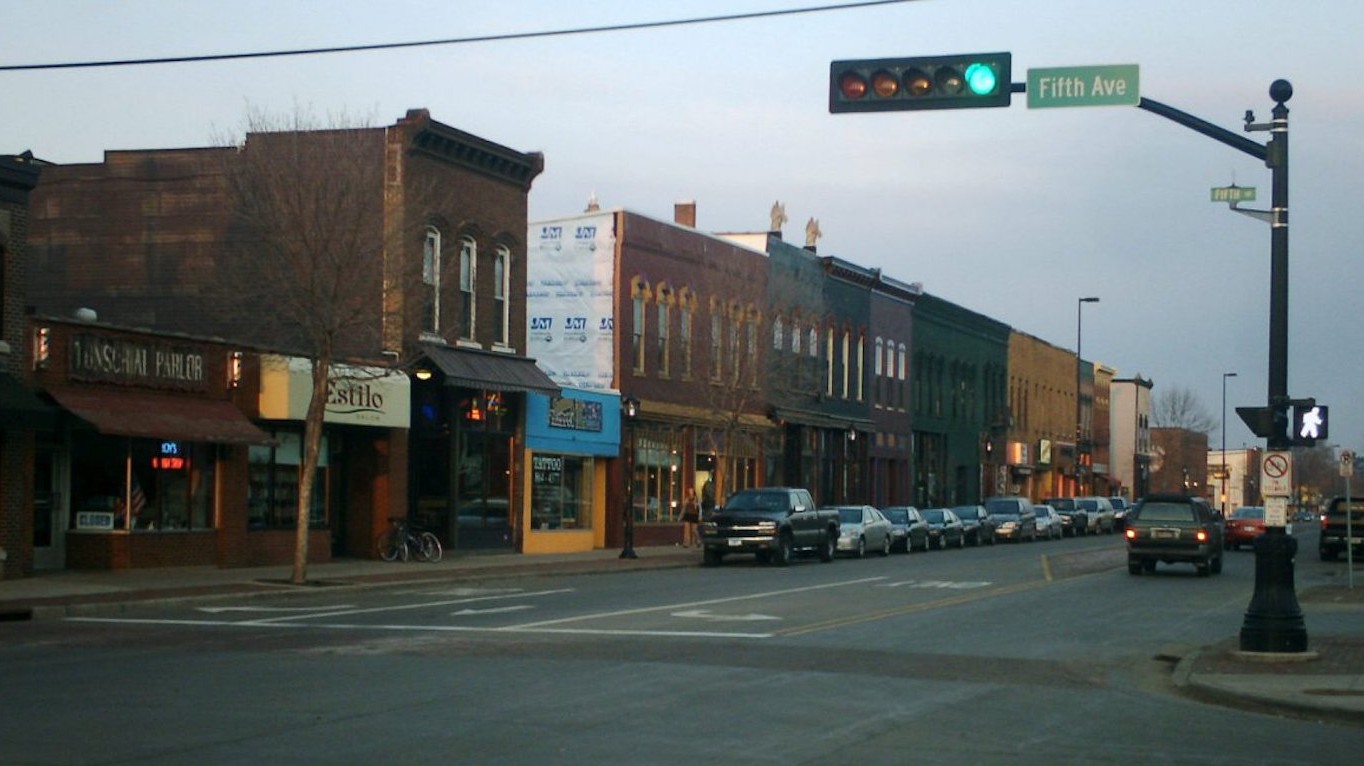
2. Eau Claire, WI
> Pct. adults drinking to excess: 26.2%
> Pct. driving deaths involving alcohol: 38.9%
> Est. number of bars: 98
> Median household income: $52,094
The excessive adult drinking rate in Eau Claire is the second highest among U.S. metro areas, with 26.2% of the adult population reporting drinking excessively in the last 30 days. There are about 5.9 bars in the metro area per 10,000 residents, the second highest concentration of any U.S. metro area.
On an individual level, excessive drinking can have a number of health consequences, none of which are good. Still, adults in Eau Claire tend to be relatively healthy. Only 13.2% of metro area adults report being in fair or poor health, a smaller share than the 15.0% of American adults.
[in-text-ad-2]

1. Green Bay, WI
> Pct. adults drinking to excess: 26.5%
> Pct. driving deaths involving alcohol: 50.5%
> Est. number of bars: 138
> Median household income: $54,847
The excessive drinking rate among adults in Green Bay is the highest of any metro area in the country. Nearly 27% of adults report they heavy or binge drinking in the last 30 days, well above the 18% excessive drinking rate nationwide.
According to the CDC, binge drinkers are 14 times more likely to report alcohol-impaired driving than those who do not binge drink. The Green Bay metro area is one of only five nationwide where over half of all deadly car accidents involve alcohol. In comparison, 30% of driving deaths nationwide involve alcohol.
The Driest Cities in America:
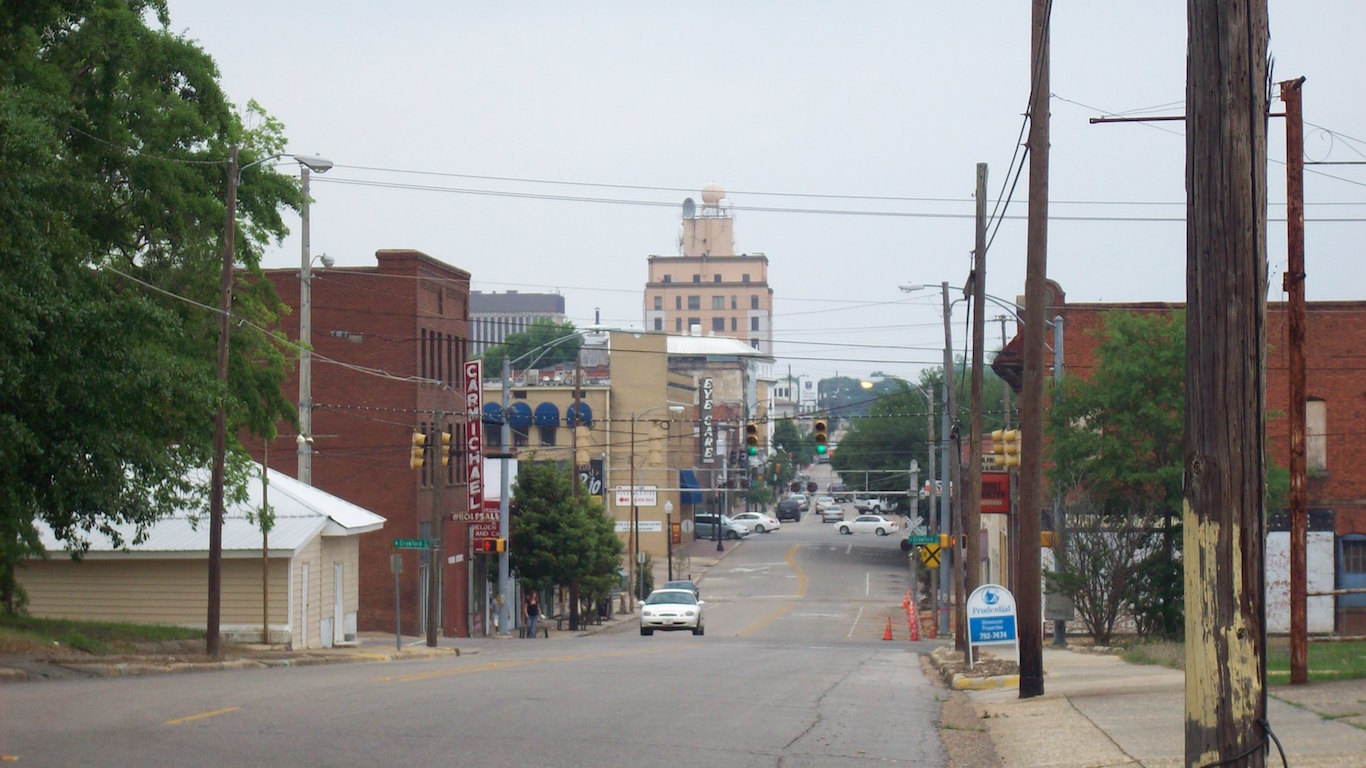
20. Dothan, AL
> Pct. adults drinking to excess: 13.0%
> Pct. driving deaths involving alcohol: 21.6%
> Est. number of bars: 13
> Median household income: $42,492
Most of the metro areas with the lowest excessive drinking rates are in the South, and Dothan, Alabama is among them. Only 13% of adults in the metro area drink excessively, well below the 18.0% share of adults who do nationwide.
Low excessive drinking rates may be tied to incomes in the area. People living in households earning $75,000 or more a year are more likely to drink excessively than people living in poorer households. In Dothan, the typical household earns only about $42,500 a year, nearly $2,300 less than the statewide median and about $13,300 less than the national median.
[in-text-ad]
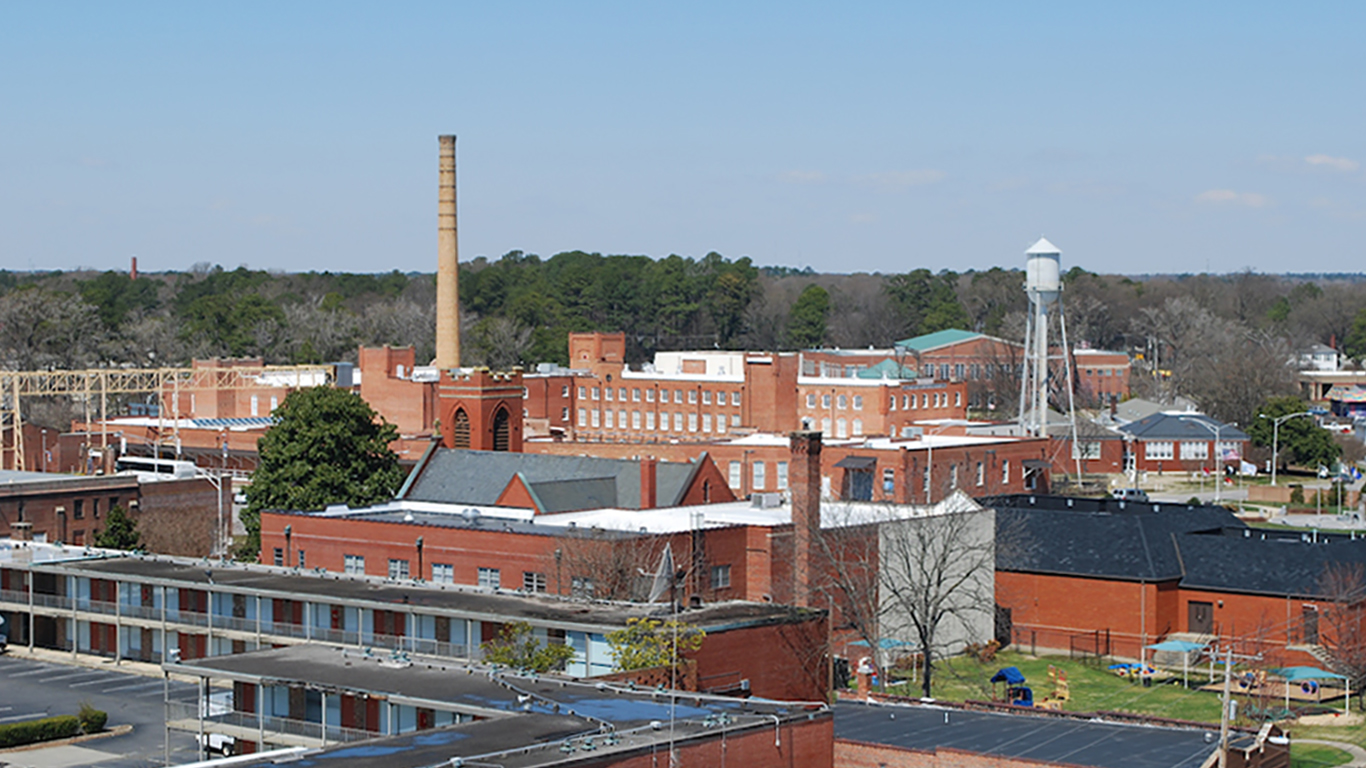
19. Rocky Mount, NC
> Pct. adults drinking to excess: 13.0%
> Pct. driving deaths involving alcohol: 31.3%
> Est. number of bars: 2
> Median household income: $37,324
Poorer households are less likely to drink unhealthy amounts of alcohol than wealthier ones, and Rocky Mount is one of the poorest metro areas in the United States. The typical area household earns only $37,324 annually, about $10,500 less than the statewide median and the 10th lowest median income among U.S. metro areas.
Despite the lower excessive drinking rate, Rocky Mount residents are more likely to be in fair or poor health than is typical nationwide. More than one in five metro area adults report being in fair or poor health compared to only 15% of American adults.
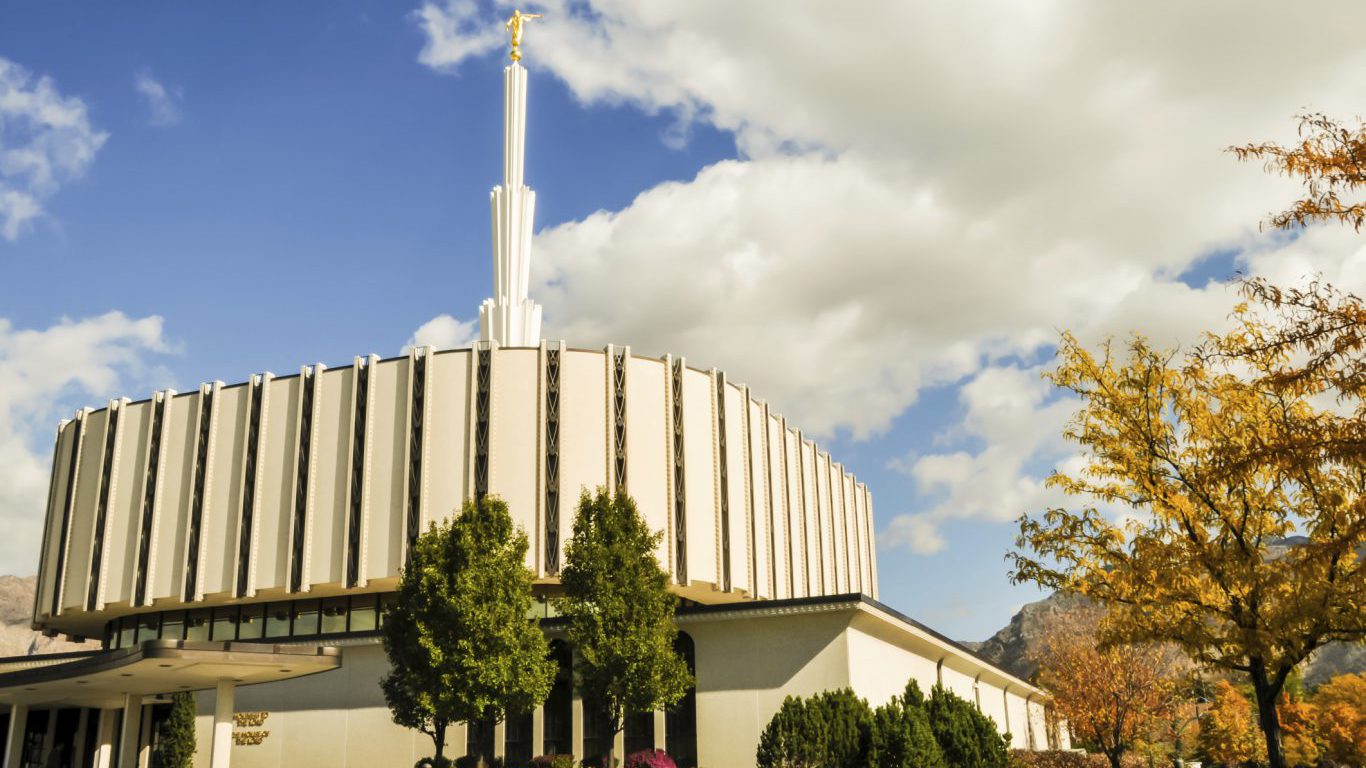
18. Ogden-Clearfield, UT
> Pct. adults drinking to excess: 12.9%
> Pct. driving deaths involving alcohol: 13.9%
> Est. number of bars: 35
> Median household income: $65,538
Just 12.9% of adults in the Ogden-Clearfield metro area drink excessively, one of the smallest shares of any city nationwide. Ogden is one of several metro areas in Utah with a large sober community, likely the result of the state’s massive religious population. An estimated 73% of Ogden residents belong to the Church of Jesus Christ of Latter-day Saints, a religion that forbids drinking alcohol.
Low demand for alcohol has likely limited the number of nightlife establishments in the area. There is just one bar for every 20,000 residents in Ogden, among the least of any metro area and less than half the comparable the national ratio.
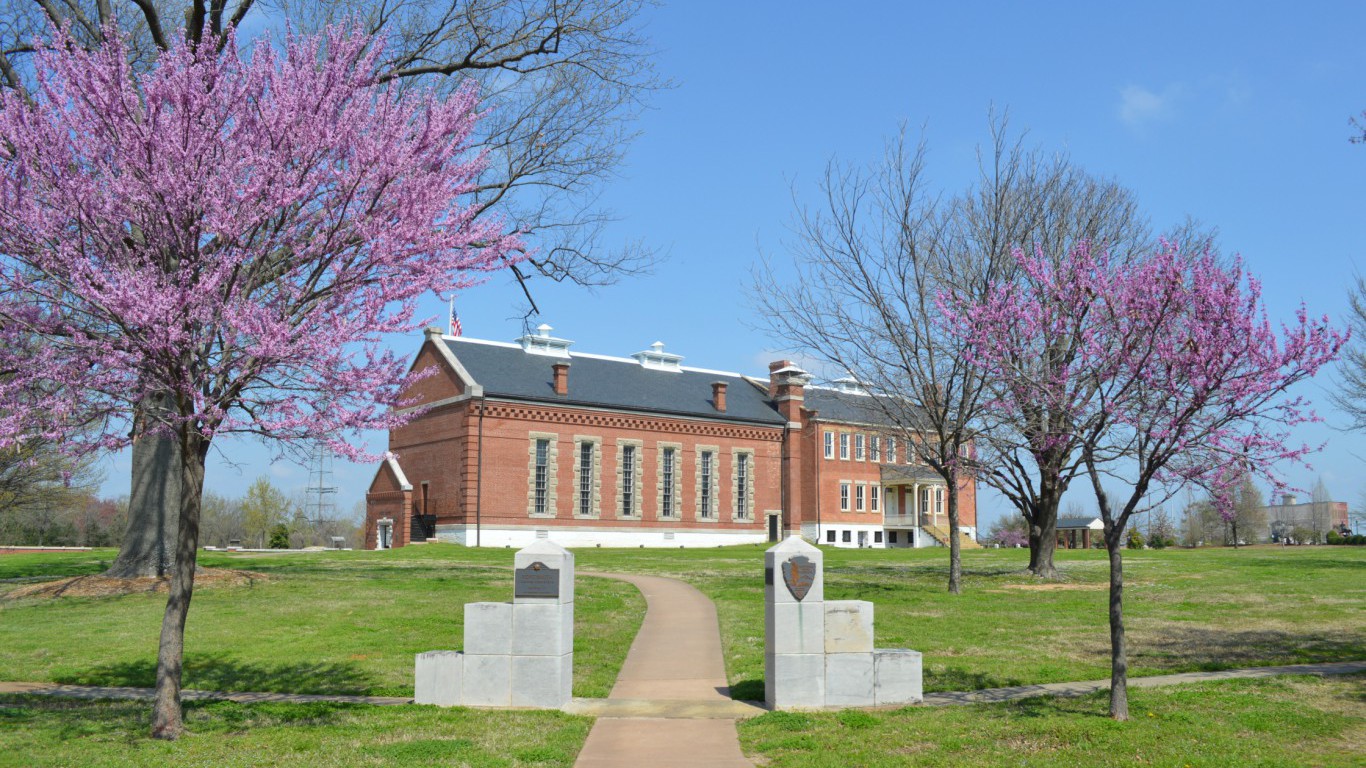
17. Fort Smith, AR-OK
> Pct. adults drinking to excess: 12.9%
> Pct. driving deaths involving alcohol: 31.7%
> Est. number of bars: 11
> Median household income: $41,040
Just 12.9% of Fort Smith adults drink excessively, a smaller share than the 18.0% of adults who do nationwide and among the least of any U.S. metro area. While binge drinking is most common among households with annual incomes greater than $75,000, the typical Fort Smith household earns just $41,040 a year.
While excessive drinking is relatively scarce in Fort Smith, other unhealthy behaviors are common. For example, more than one in five area adults smoke and more than one in three are obese, each well above the 18.0% U.S. smoking rate and the 28.0% obesity rate. Due in part to unhealthy lifestyles, 22.1% of adults are in fair or poor health, well above the 15.0% national share.
[in-text-ad-2]
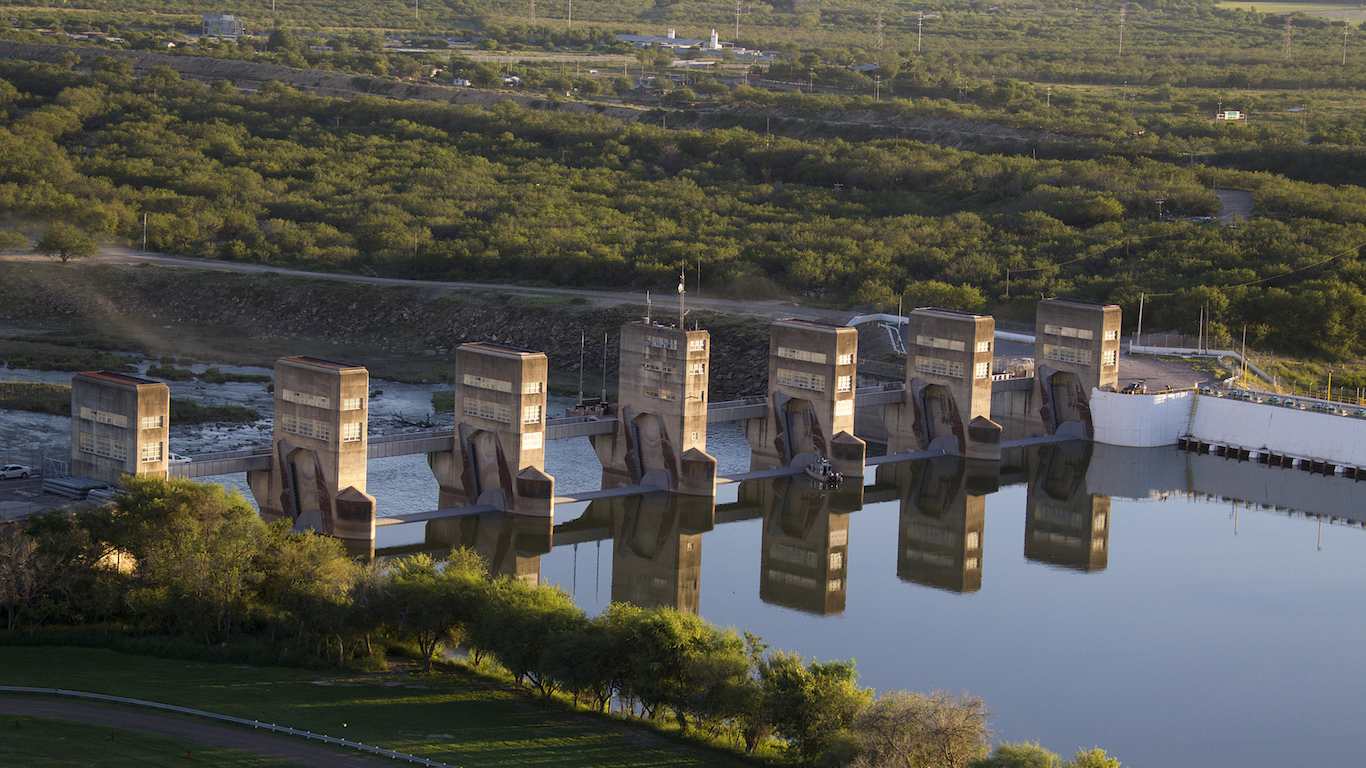
16. McAllen-Edinburg-Mission, TX
> Pct. adults drinking to excess: 12.8%
> Pct. driving deaths involving alcohol: 27.9%
> Est. number of bars: 47
> Median household income: $35,730
Poorer individuals are less likely to drink excessively than wealthier ones, and with a median household income of $35,730 a year, the McAllen metro area is the third poorest in the United States. In addition to one of the lowest excessive drinking rates in the country, smoking is also relatively uncommon among adults in McAllen. Only 14.3% of metro area adults smoke, well below the 18.0% U.S. smoking rate.
Despite a low smoking and excessive drinking rates, poor health is relatively common among the McAllen population. Some 32.3% of area adults report being in fair or poor health, the second largest share of any U.S. metro area.
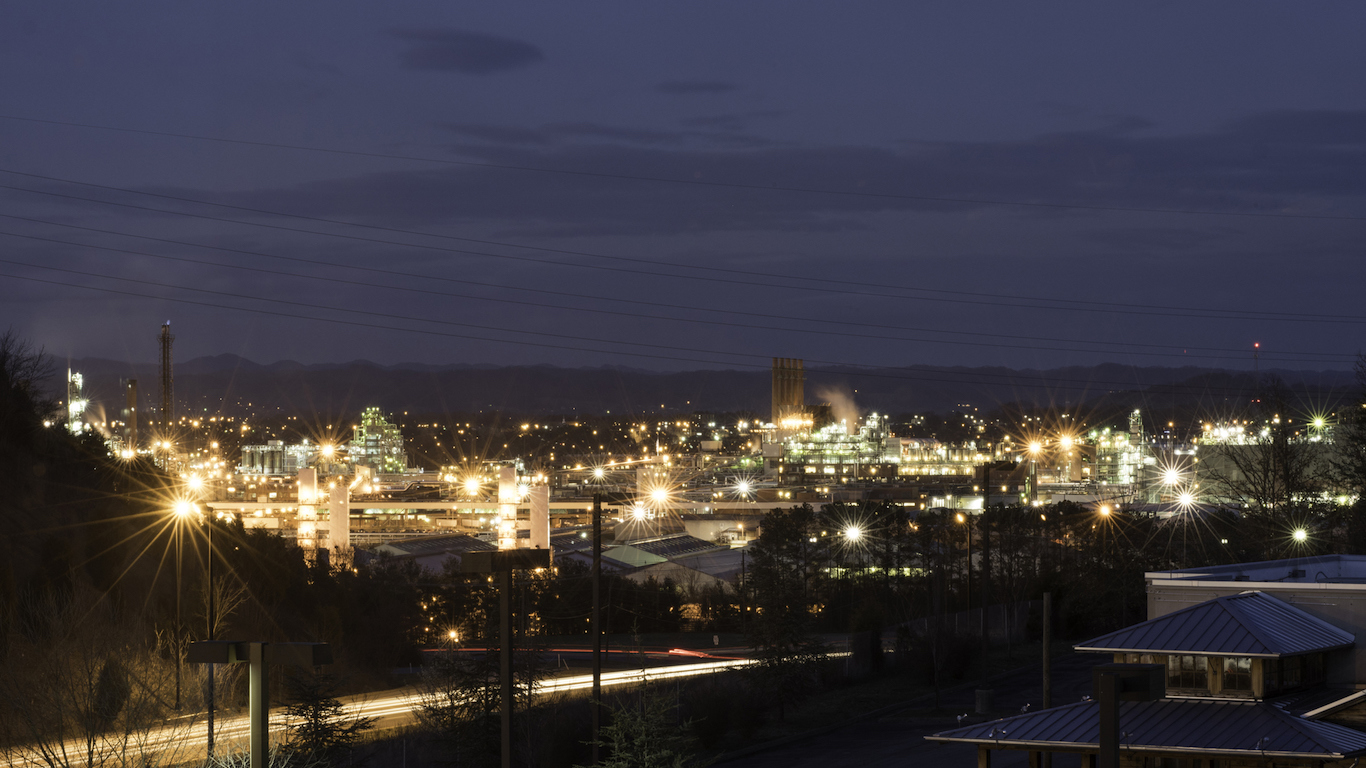
15. Kingsport-Bristol-Bristol, TN-VA
> Pct. adults drinking to excess: 12.7%
> Pct. driving deaths involving alcohol: 19.8%
> Est. number of bars: 10
> Median household income: $41,206
Only 11.2% of adults in Tennessee drink excessively, the smallest share of any state in the country. While excessive drinking is slightly more common in Kingsport, the 12.7% of metro area adults who drink excessively is one of the smallest shares of all major U.S. metro areas.
Binge drinking is associated with higher rates of sexually transmitted disease. In Kingsport, the rate of chlamydia diagnosis of 210 for every 100,000 people is one of the lowest of any metro area and well below the 456 diagnoses per 100,000 national rate.
[in-text-ad]
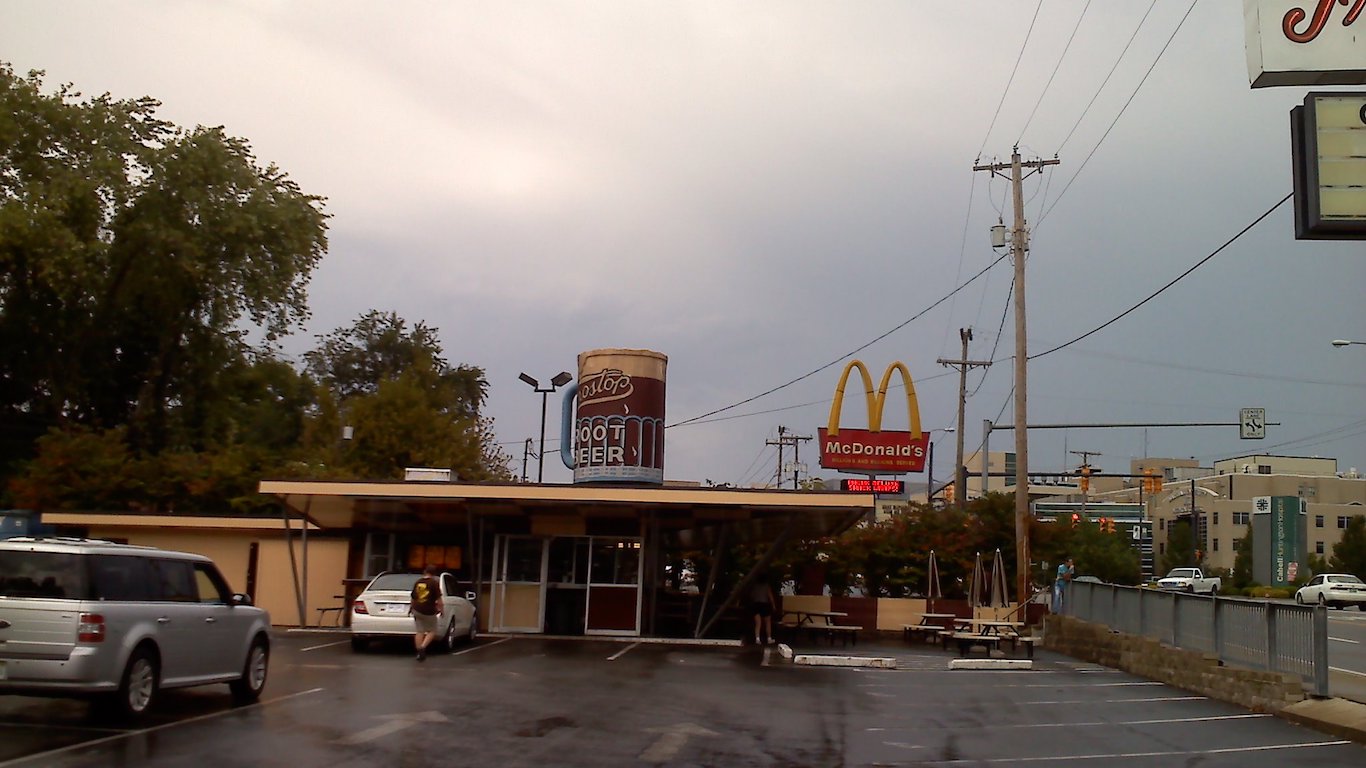
14. Huntington-Ashland, WV-KY-OH
> Pct. adults drinking to excess: 12.6%
> Pct. driving deaths involving alcohol: 26.5%
> Est. number of bars: 58
> Median household income: $42,237
Just 12.6% of adults in the Huntington-Ashland metro area drink excessively, one of the smallest shares of any city nationwide. The prevalence of binge drinking decreases with income, and the typical Huntington household earns just $42,237 a year — among the least of any U.S. city.
Young people are more likely to binge drink than their older counterparts and binge drinking is by far the most common form of excessive drinking. A low excessive drinking rate in the Huntington-Ashland metro area may be attributable to the age of the population. The median age in the metro area is 40.9 years, considerably higher than the national median age of 37.8 years.
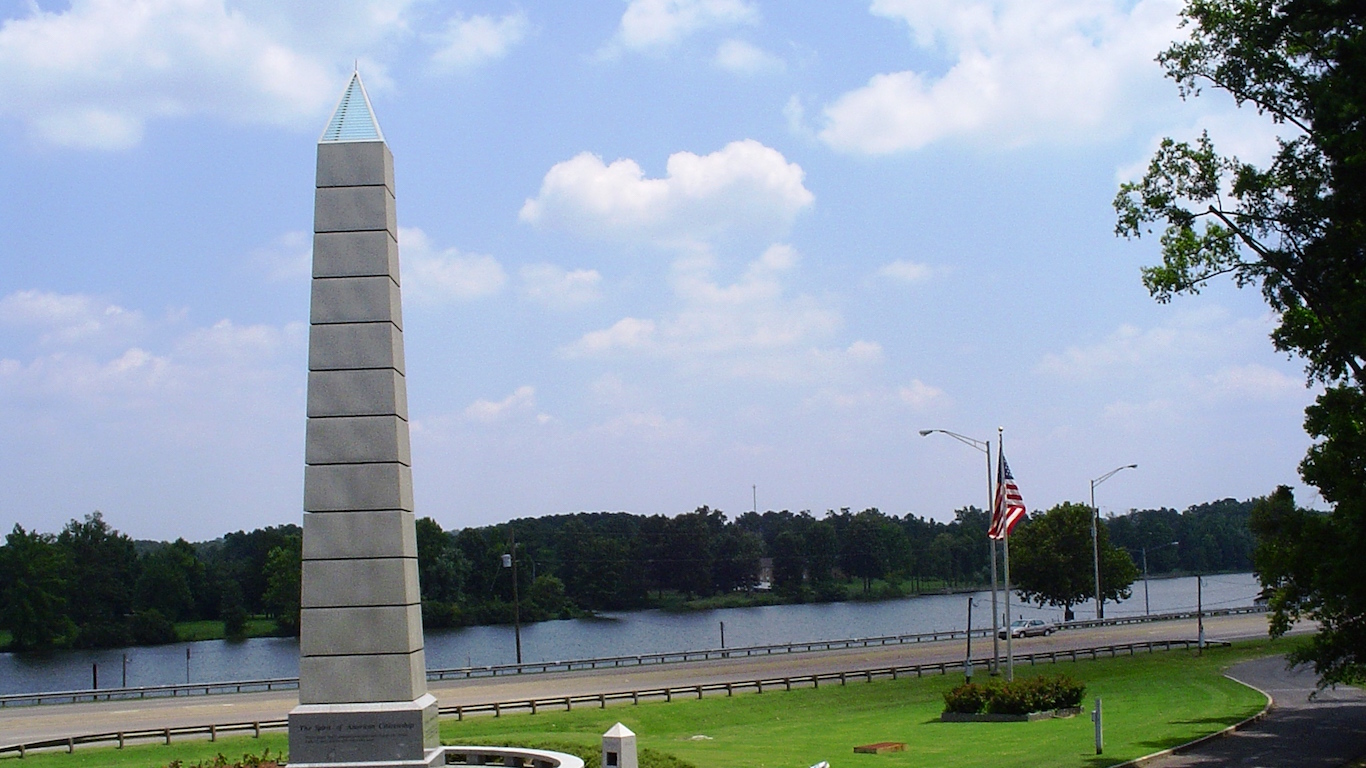
13. Gadsden, AL
> Pct. adults drinking to excess: 12.4%
> Pct. driving deaths involving alcohol: 31.5%
> Est. number of bars: 7
> Median household income: $43,346
Men who average more than two drinks per day and women who average more than one are considered excessive drinkers. While 18.0% of American adults nationwide drink excessively, just 12.4% of Gadsden adults have heavy or binge drinking habits. Poorer individuals are less likely to drink excessively than wealthier Americans, and the typical Gadsden household earns just $43,346 a year — approximately $11,000 less than the U.S. median income of $55,775.
Low demand for alcohol has likely resulted in a limited number of nightlife establishments in Gadsden. The Census counts just seven bars in the Gadsden metro area, equal to only 0.7 bars for every 10,000 residents, one of the smaller rations of any city when adjusted for population.

12. Knoxville, TN
> Pct. adults drinking to excess: 12.3%
> Pct. driving deaths involving alcohol: 28.9%
> Est. number of bars: 52
> Median household income: $48,382
Knoxville is one of several cities in Tennessee with a large, relatively sober population. Just 12.3% of metro area residents drink excessively, less than the 18.0% national share and among the least of any city nationwide. People living in low income households are less likely to engage in heavy or binge drinking, and the typical household in Knoxville earns just $48,382 annually — roughly $7,000 less than the national median household income.
Knoxville residents also have relatively limited access to alcohol. Sales of packaged liquor in Knoxville are not permitted on Sundays or between the hours of 11:00 p.m. and 8:00 a.m. on other days.
[in-text-ad-2]
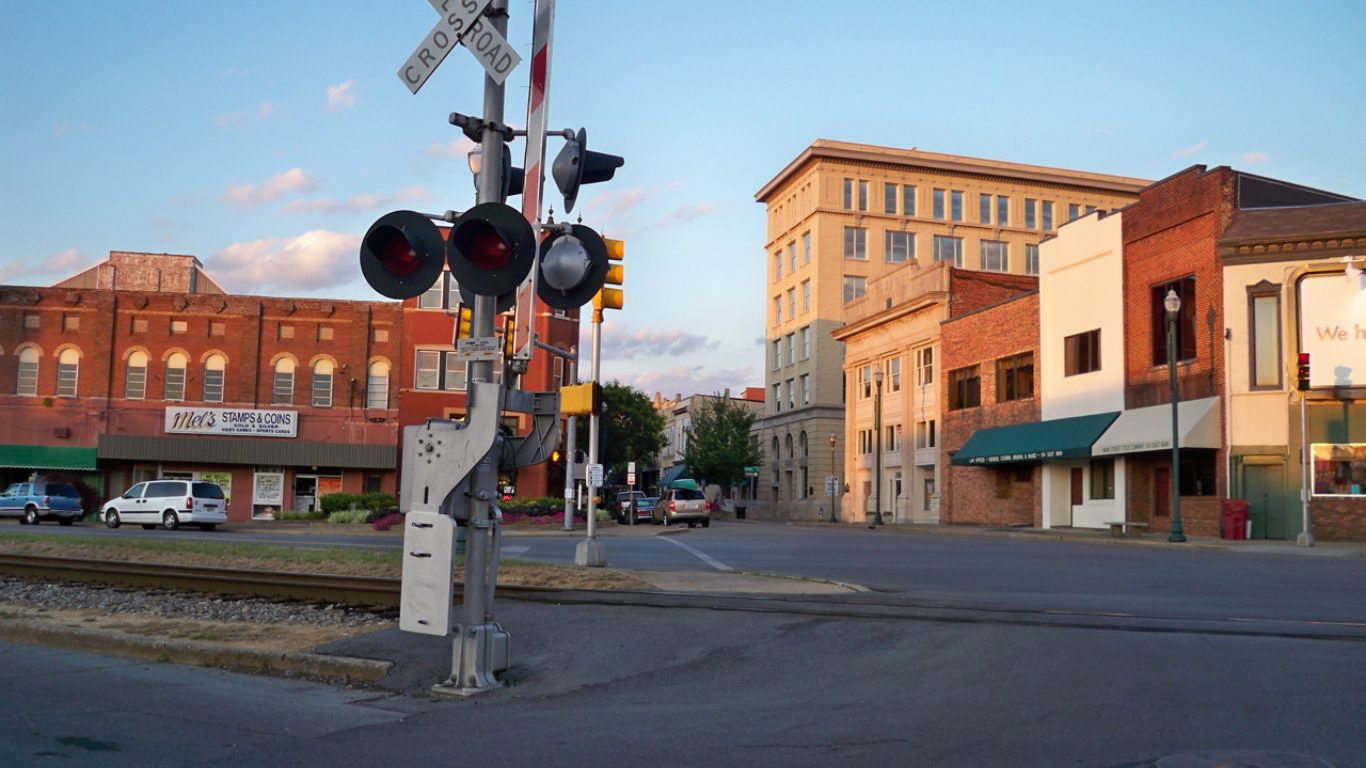
11. Johnson City, TN
> Pct. adults drinking to excess: 12.3%
> Pct. driving deaths involving alcohol: 31.7%
> Est. number of bars: 7
> Median household income: $40,388
Men who average more than two drinks per day and women who average more than one are considered excessive drinkers. Just 12.3% of Johnson City adults drink excessively, one of the smaller shares nationwide. Poor individuals are less likely to engage in heavy or binge drinking, and more than one in five Johnson City residents live in poverty, a far greater share than the 14.7% national poverty rate.
The small share of heavy drinkers in Johnson City may not create enough demand for an active nightlife in the metro area. The Census counts just seven bars in Johnson City, equal to only about 0.3 for every 10,000 residents, one of the lowest rations of any metro area when adjusted for population.

10. Cleveland, TN
> Pct. adults drinking to excess: 12.2%
> Pct. driving deaths involving alcohol: 41.0%
> Est. number of bars: 4
> Median household income: $42,380
Cleveland is one of several relatively poor Tennessee metro areas where the rate of excessive alcohol consumption is nearly the lowest in the country. The typical Cleveland household earns just $42,380 a year, less than the $55,775 national median income. People need to be able to afford alcohol in order to drink and low incomes may partially explain why only 12.2% of adults in Cleveland drink excessively, a small share compared to the 18.0% national figure.
One factor affecting alcohol consumption in Cleveland may be the area’s strict alcohol laws. While bars and restaurants are permitted to sell liquor by the drink in Cleveland, sale of packaged liquor is prohibited in the city.
[in-text-ad]
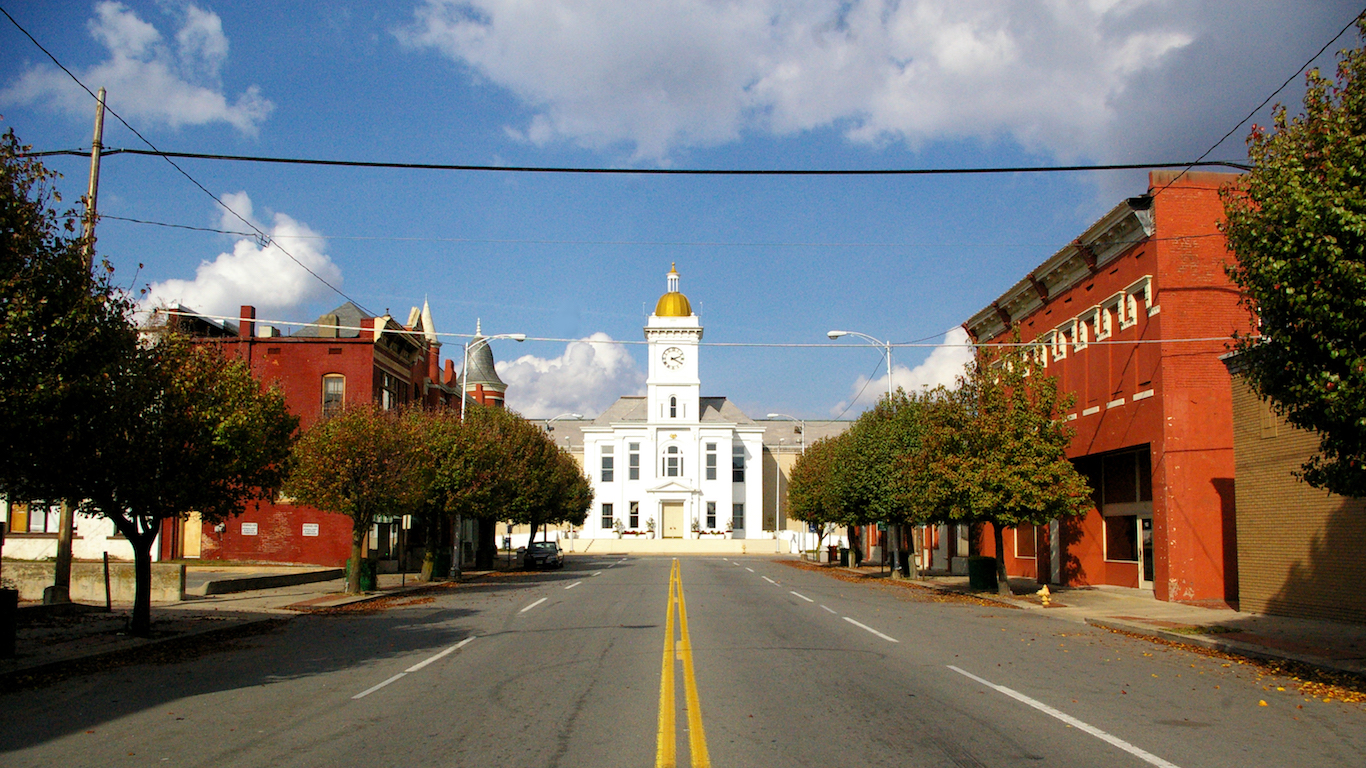
9. Pine Bluff, AR
> Pct. adults drinking to excess: 12.2%
> Pct. driving deaths involving alcohol: 34.8%
> Est. number of bars: 1
> Median household income: $36,538
Only 12.2% of adults in the Pine Bluff metro area drink excessively, one of the smallest shares of any U.S. metro. The prevalence of excessive drinking tends to increase with access, and for many Pine Bluff residents drinking is unaffordable. The typical area household earns only $36,538 a year, one of the lowest median incomes of any U.S. metro area and nearly $20,000 below the nationwide median income of $55,775. Pine Bluff residents also lack the access to drinking establishments. On a per capita basis, the concentration of bars in the metro area is nearly the lowest of any U.S. metro area.
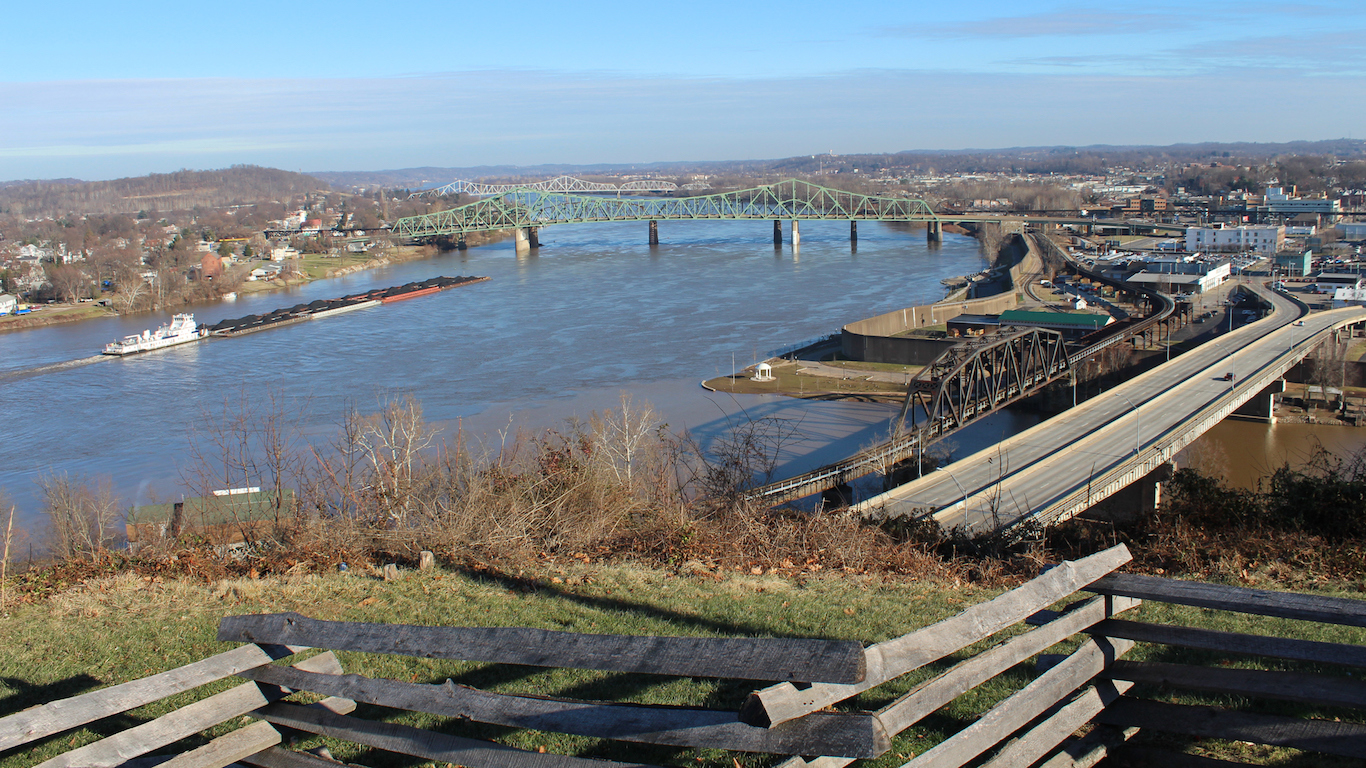
8. Parkersburg-Vienna, WV
> Pct. adults drinking to excess: 12.2%
> Pct. driving deaths involving alcohol: 30.6%
> Est. number of bars: 21
> Median household income: $40,547
Only 12.2% of adults in the Parkersburg-Vienna metro area drink excessively, one of the smallest shares of U.S. metros and the third smallest share of West Virginia metros. Apart from a relatively low excessive drinking rate, Parkersburg-Vienna adults tend to report less healthy behaviors. The area’s smoking rate of 24.8% is the highest of any metro area in the United States. Adults in the area also struggle with weight issues, as 36% of adults are obese, well above the 28% national obesity rate. Partially as a result, more than one in five metro area resident are in fair or poor health, well above the 15% share of American adults.

7. Morristown, TN
> Pct. adults drinking to excess: 11.9%
> Pct. driving deaths involving alcohol: 26.4%
> Est. number of bars: N/A
> Median household income: $40,041
Excessive drinking is more common in wealthy households and many residents may not be able to afford to drink every day in Morristown, where the median household income is just $40,041 a year and nearly 18% of residents live in poverty. Just 11.9% of Morristown adults drink excessively, nearly the smallest share among U.S. metro areas.
While Morristown adults largely abstain from heavy and binge drinking, residents in the area engage in other dangerous and unhealthy behaviors. Every year, approximately 430 in every 100,000 residents die from injury– one of the highest injury death rates in the country. The leading cause of injury death is drug overdose.
[in-text-ad-2]

6. Logan, UT-ID
> Pct. adults drinking to excess: 11.6%
> Pct. driving deaths involving alcohol: 16.7%
> Est. number of bars: 1
> Median household income: $51,555
Just 11.6% of adults in the Logan metro area drink excessively, the sixth smallest share nationwide. While residents of many of the driest U.S. cities are relatively poor and likely abstain from excessive alcohol use for financial reasons, Logan is only slightly less wealthy than the country as a whole.
One factor behind Logan’s relatively low alcohol consumption rate may be the city’s large religious population. Roughly 87% of Logan residents belong to the Church of Jesus Christ of Latter-day Saints, a religion in which the consumption of alcohol and tobacco are forbidden. Just 8.6% of Logan adults smoke, the third smallest share of U.S. metro areas.
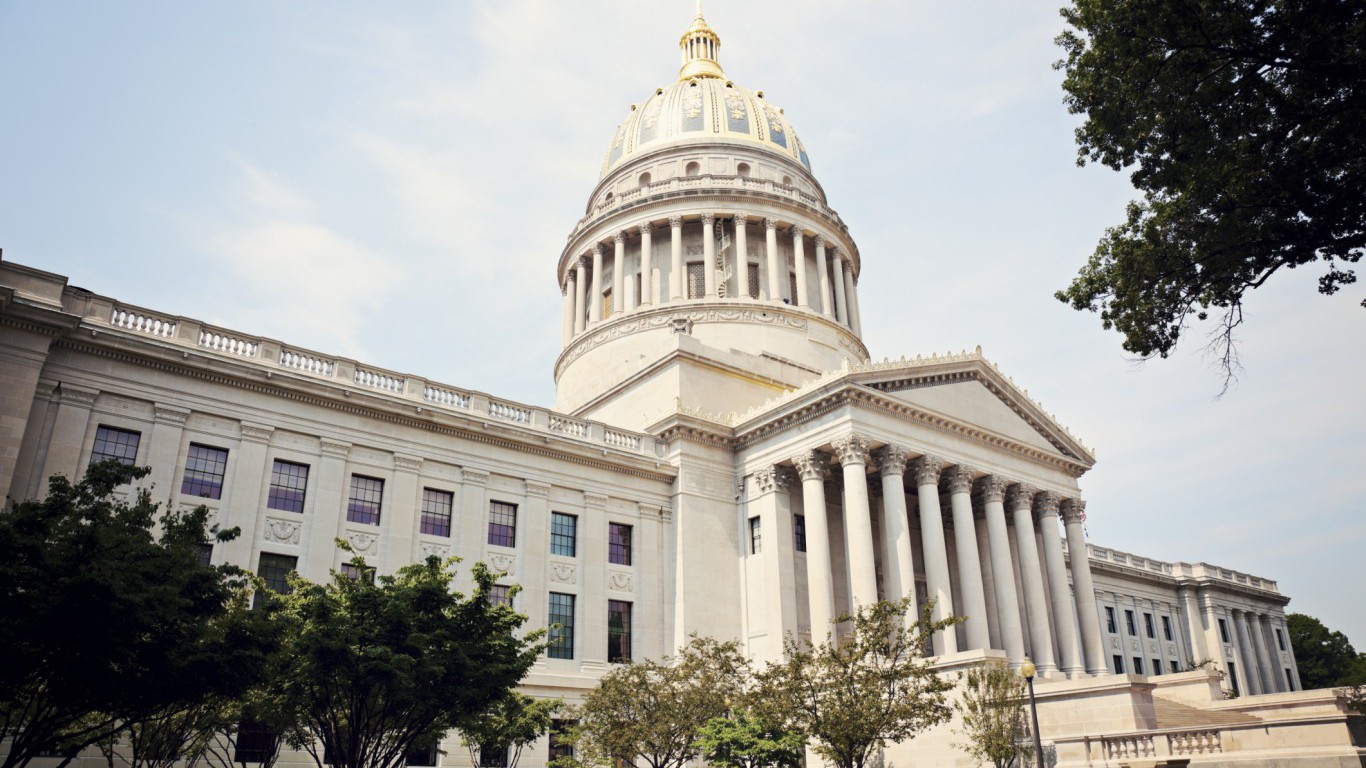
5. Charleston, WV
> Pct. adults drinking to excess: 11.1%
> Pct. driving deaths involving alcohol: 28.7%
> Est. number of bars: 46
> Median household income: $42,526
Alcohol consumption is a luxury activity for many Americans and therefore is more prevalent in more affluent parts of the country. The typical household in the Charleston metro area earns just $42,526 annually, far less than the $55,775 national median. Only 11.1% of area adults drink excessively, a small share compared to the 18.0% national figure.
While many Charleston adults do not engage in excessive drinking, many also abstain from healthy activities that also often require money. Just 67% of the metro population has access to locations for physical activity like gyms and health clubs compared to 84% of Americans. Roughly 28% of Charleston adults do not exercise regularly, one of the larger shares nationwide.
[in-text-ad]
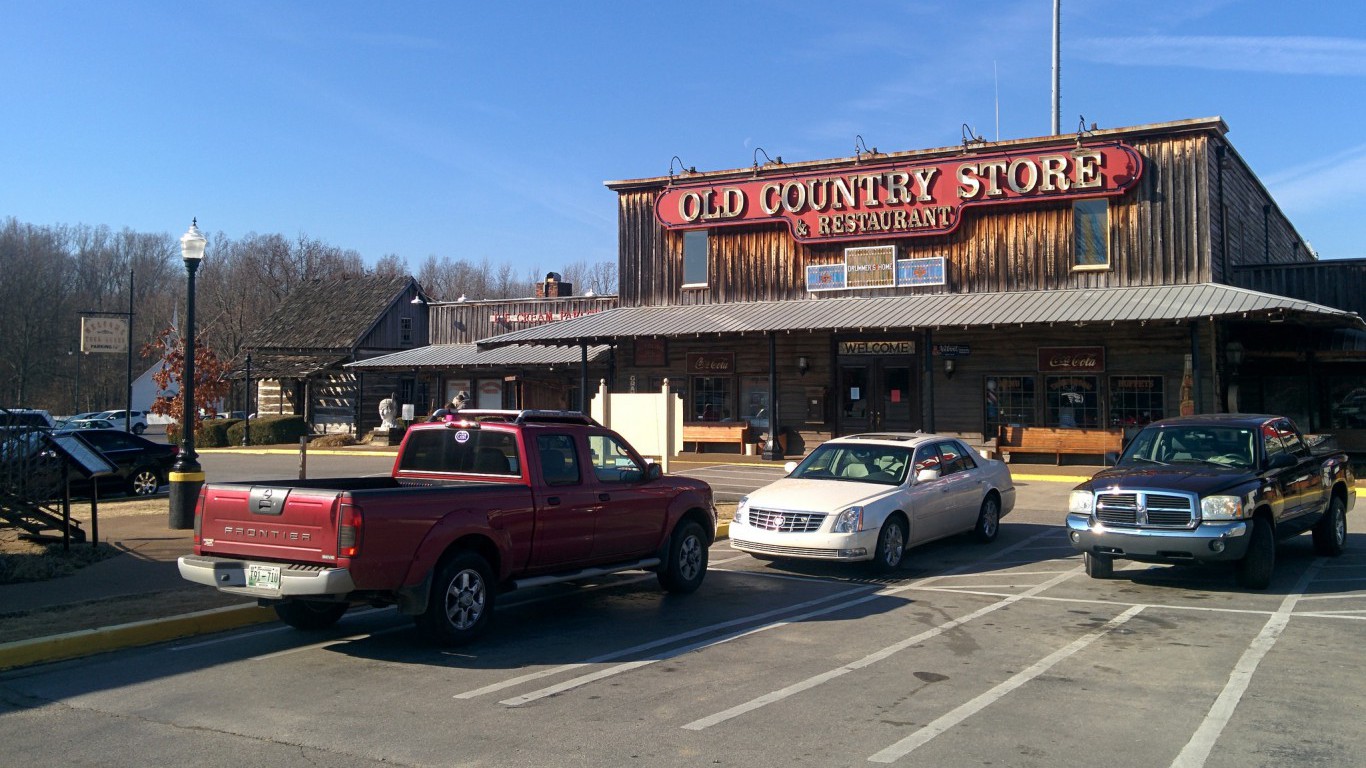
4. Jackson, TN
> Pct. adults drinking to excess: 10.9%
> Pct. driving deaths involving alcohol: 30.7%
> Est. number of bars: 7
> Median household income: $46,553
Just 10.9% of adults in the Jackson metro area engage in either binge or heavy drinking, the fourth smallest share in the country.
While many adults in the metro area are healthier for not binge drinking, other unhealthy habits are relatively common in Jackson. For example, 21.4% of residents smoke, well above the 18.0% U.S. smoking rate. Additionally, only 65% of Jackson residents have access to locations for physical activity like gyms and health clubs, and only 71% of adults exercise regularly — each the smaller shares of all U.S. metro areas.
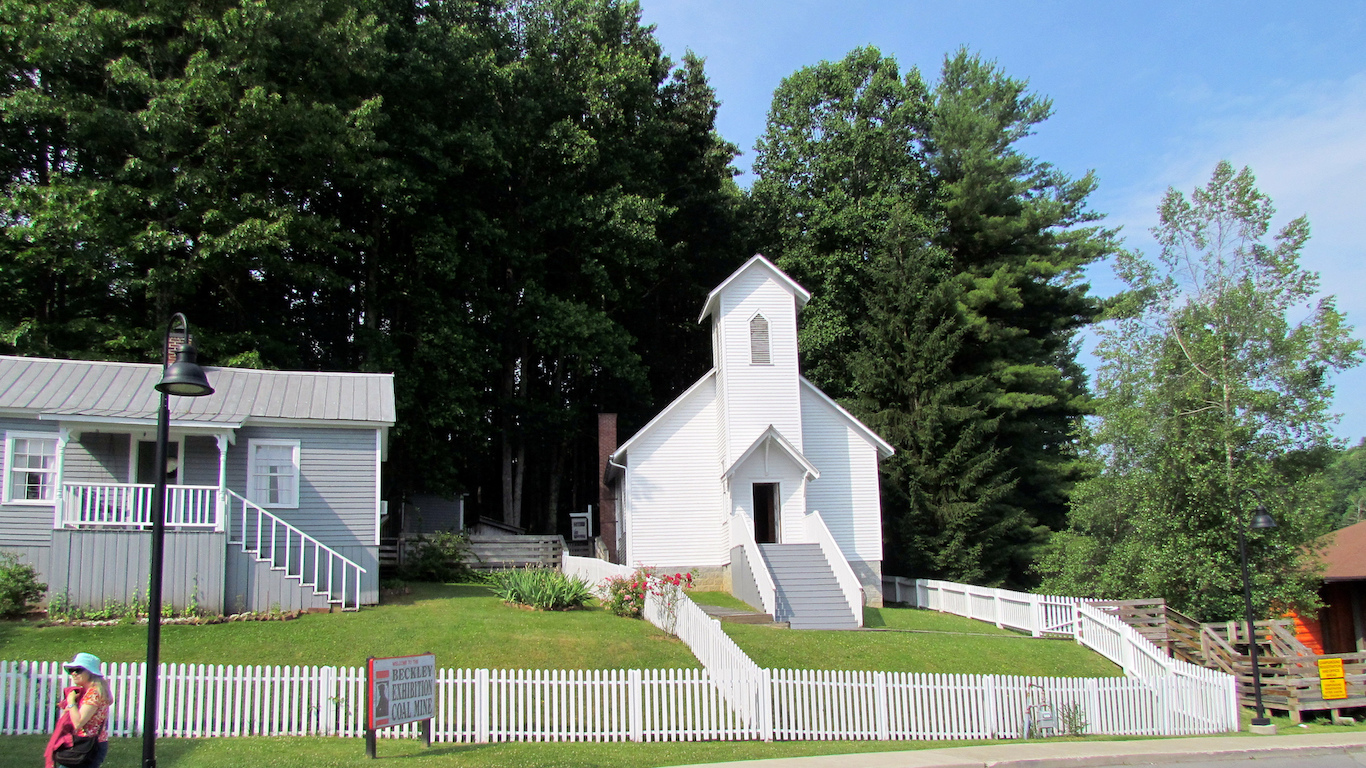
3. Beckley, WV
> Pct. adults drinking to excess: 10.8%
> Pct. driving deaths involving alcohol: 27.9%
> Est. number of bars: 20
> Median household income: $37,101
Alcohol consumption is more prevalent in the most affluent parts of the country, where residents have more disposable income and greater access to alcohol through bars and restaurants. Many residents may not be able to afford such luxury goods in the Beckley metro area, the typical household earns only $37,101 a year, one of the lowest median household incomes of all U.S. metro areas. Just 10.8% of adults in Beckley drink excessively, the third smallest share of metro areas nationwide.
Excessive alcohol consumption is more common among younger populations, and the median age in Beckley of 43.1 years is well above the 37.8 year national median.
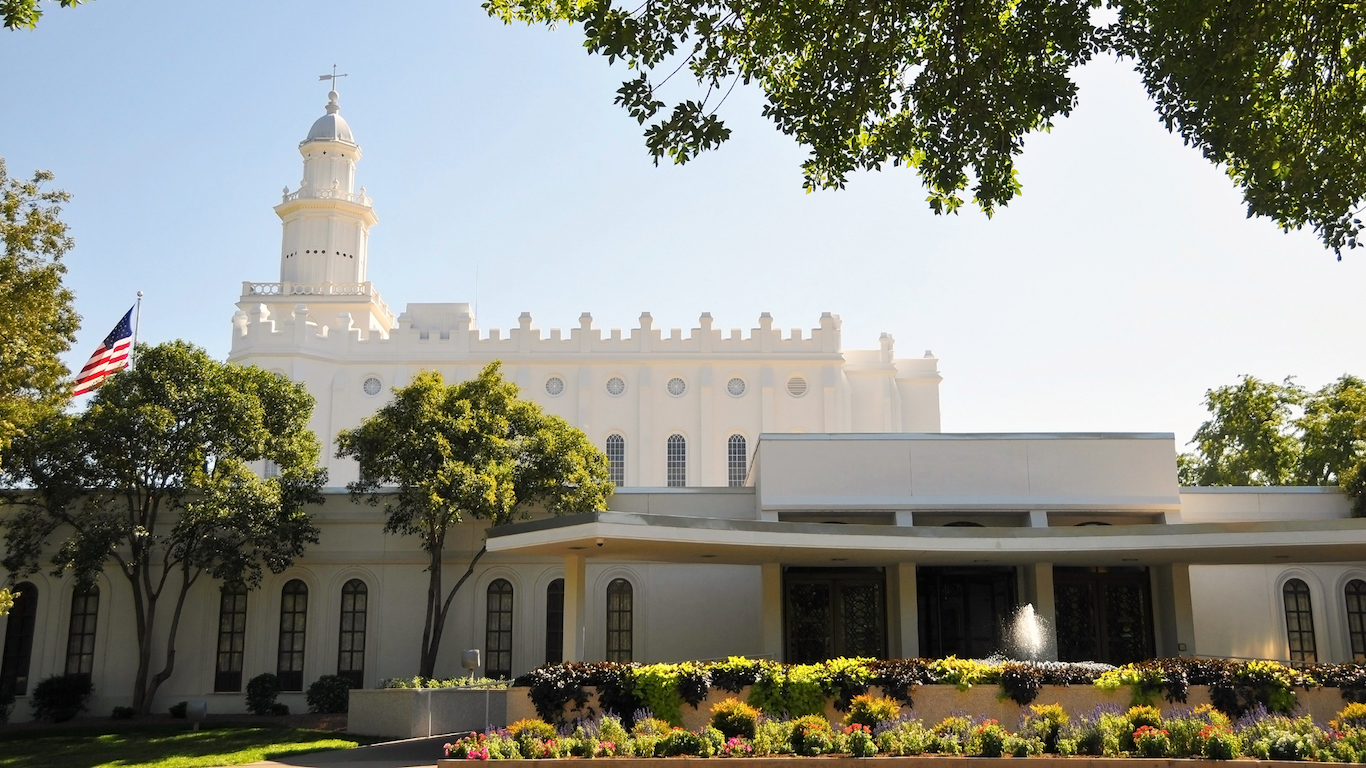
2. St. George, UT
> Pct. adults drinking to excess: 10.8%
> Pct. driving deaths involving alcohol: 15.9%
> Est. number of bars: 2
> Median household income: $54,913
Just 10.8% of St. George adults regularly drink heavily or binge drink, the second smallest share of any metro area in the country. While residents of many of the driest U.S. cities likely abstain from drinking alcohol for financial reasons, St. George is about as wealthy as the average American metro area.
One factor behind the low alcohol consumption among St. George adults may be the city’s large religious population. An estimated 70% of St. George residents belong to the Church of Jesus Christ of Latter-day Saints, a faith that forbids consumption of alcohol and tobacco. Similarly, just 8.9% of adults in St. George smoke, the fourth smallest share nationwide.
[in-text-ad-2]
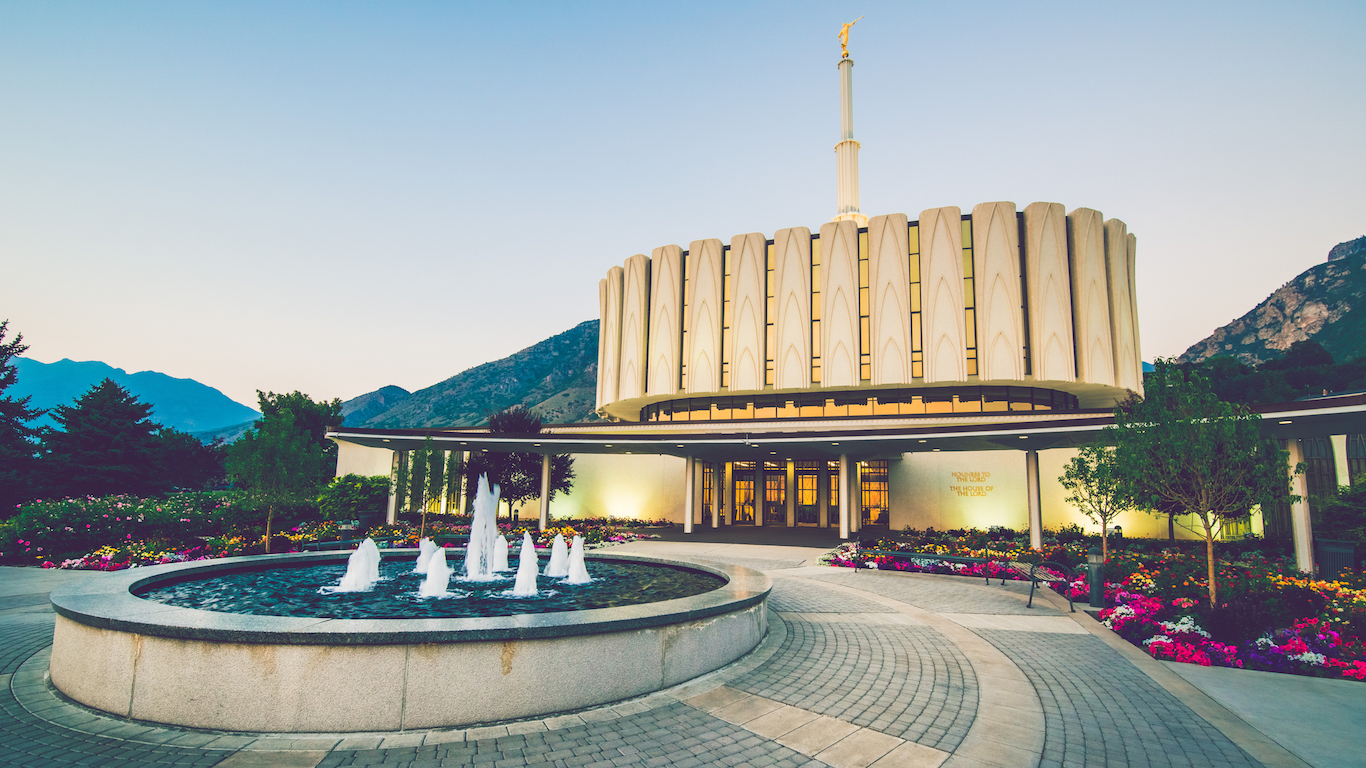
1. Provo-Orem, UT
> Pct. adults drinking to excess: 8.5%
> Pct. driving deaths involving alcohol: 14.3%
> Est. number of bars: 10
> Median household income: $65,092
In the Provo-Orem metro area, the typical household earns $65,092 a year, and nearly two in five adults have a bachelor’s degree — each some of the largest such figures nationwide. While alcohol consumption tends to be more prevalent in wealthier parts of the country, where disposable income is higher and there is often greater access to bars, Provo-Orem is the driest city in the country. Just 8.5% of metro area adults drink excessively, less than half the 18.0% national share.
One reason behind Provo’s low alcohol consumption rate is likely the area’s large Mormon population. Some 93% of Provo-Orem residents belong to the Church of Jesus Christ of Latter-day Saints, which forbids the consumption of alcohol and tobacco. In addition to low alcohol consumption rates, just 6.6% of Provo adults smoke, the smallest share nationwide.
Detailed Findings:
According to the CDC, excessive drinking includes binge drinking — defined as five or more drinks on a single occasion for men and four or more for women — and heavy drinking — defined as 15 or more drinks a week for men and eight or more for women.
Excessive drinking is indisputably bad for your health. Yet, because alcohol consumption is also income-dependent — the CDC reports households earning at least $75,000 a year are more likely to drink excessively — the heaviest drinking cities tend to be healthier and more prosperous than the driest cities. In all of the 20 heaviest drinking cities a smaller share of adults report being in fair or poor health than the 15.0% national share. Similarly, 18 of the 20 heaviest drinking cities have a lower premature death rate than the nationwide rate. The opposite is generally true in cities with the lowest excessive drinking rates.
In an interview with 24/7 Wall St., Aaron White, Senior Scientific Advisor to the Director of the National Institute of Alcohol Abuse and Alcoholism, explained the apparent contradiction.
“Alcohol is just one of many health related variables,” White said. Understanding that excessive alcohol consumption is more common in higher-income areas, the same people who can afford to drink excessively can also afford otherwise healthy lifestyles. “We know that people that have more money have better access to health care and they have better access to healthier food,” White said.
Bars are more accessible in cities with high excessive drinking rates. Nationwide, there are about 1.3 bars for every 10,000 people. In 15 of the 20 heaviest drinking cities, the concentration of bars is at least double the national ratio. Conversely, 16 of the driest U.S. cities have a lower concentration of bars than the U.S. as a whole. “You have to have access to alcohol to consume it, and essentially wherever there are more outlets for alcohol, there is more alcohol consumption,” White said.
Binge drinking is the most common form of excessive drinking, and younger adults are more likely than older adults to binge drink. Of the 20 heaviest drinking cities, in 13 the median age is lower than the 37.8 year national median. On the other end of the spectrum, 15 of the 20 driest cities are older than the nation as a whole. “We know that age is associated with alcohol consumption,” White confirmed.
Similarly, heavy drinking cities are more likely to have a disproportionately high share of college or graduate students than drier cities. While the gap in excessive drinking rates between colleges and non-college areas has closed in recent years, “there is more alcohol use at colleges than in the towns surrounding them,” White said.
Methodology:
To identify the U.S. cities with the highest and lowest excessive drinking rates, 24/7 Wall St. reviewed the percentage of adults 18 and older who report binge or heavy drinking within a 30 day period across 381 metro areas. Metro-level data were aggregated from county-level data provided by County Health Rankings & Roadmaps, a Robert Wood Johnson Foundation and University of Wisconsin Population Health Institute joint program. All excessive drinking data is as of 2015. Median household income, poverty rates, median age, bachelor’s degree attainment rates, and share of the population in college or graduate school came from the U.S. Census Bureau’s 2015 American Community Survey. The number of bars per capita is also from 2015 and came from County Business Patterns, a program maintained by the Census. Health outcomes and factors, including the number of premature deaths per 100,000 people annually and the percentage of adults who report being in fair or poor health were also aggregated from county-level data obtained from County Health Rankings & Roadmaps. The report was released in 2017, and specific data sets for the most recent years available.
Credit card companies are at war. The biggest issuers are handing out free rewards and benefits to win the best customers.
It’s possible to find cards paying unlimited 1.5%, 2%, and even more today. That’s free money for qualified borrowers, and the type of thing that would be crazy to pass up. Those rewards can add up to thousands of dollars every year in free money, and include other benefits as well.
We’ve assembled some of the best credit cards for users today. Don’t miss these offers because they won’t be this good forever.
Flywheel Publishing has partnered with CardRatings for our coverage of credit card products. Flywheel Publishing and CardRatings may receive a commission from card issuers.
Thank you for reading! Have some feedback for us?
Contact the 24/7 Wall St. editorial team.